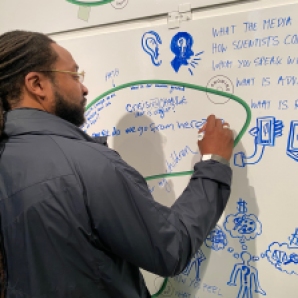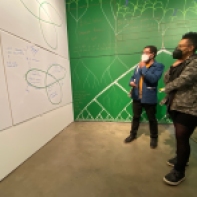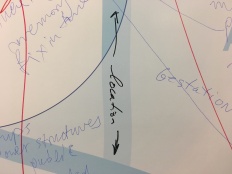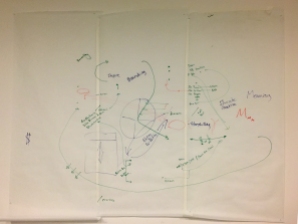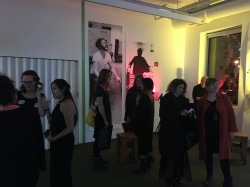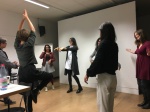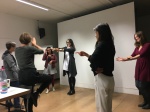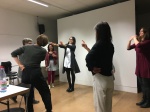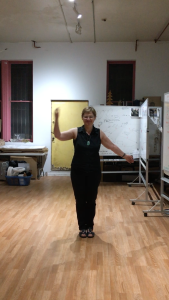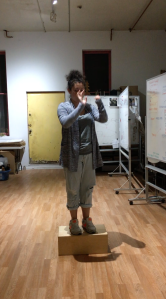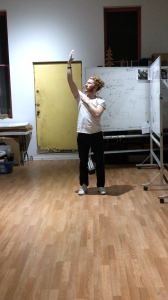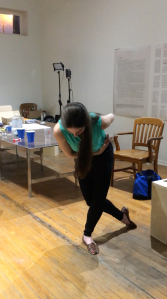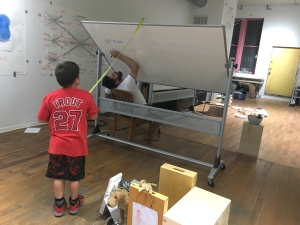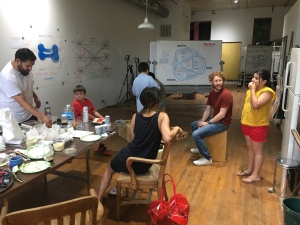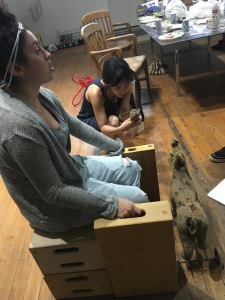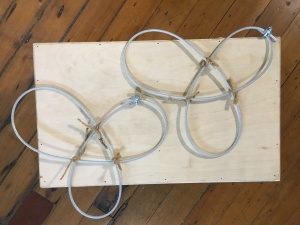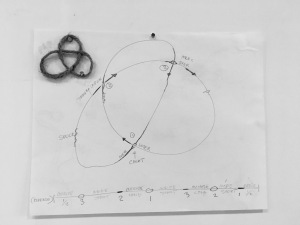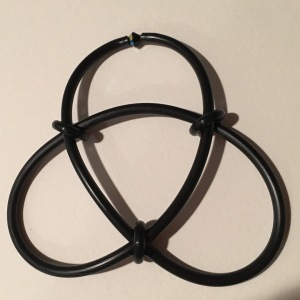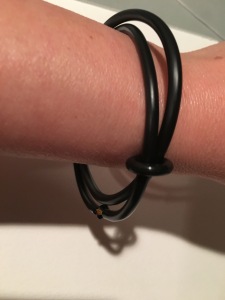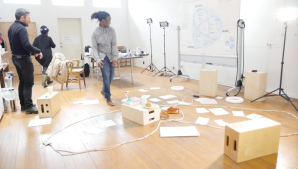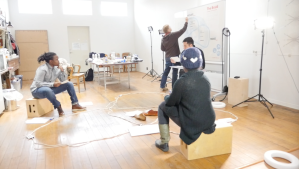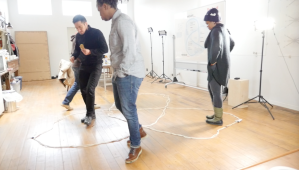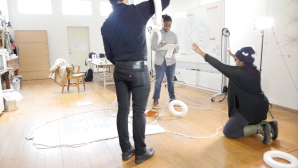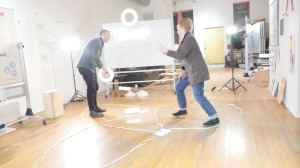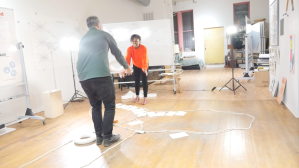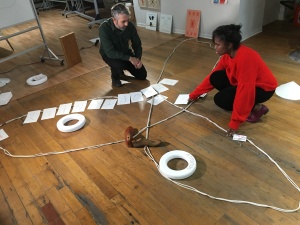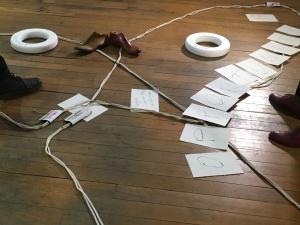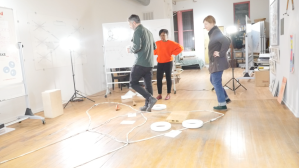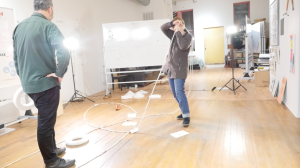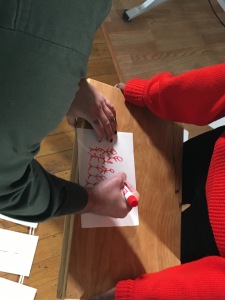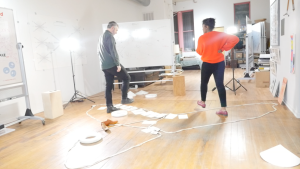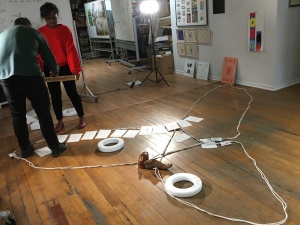Facilitating now. Royal Central School of Speech and Drama, London, UK
PSi#29, Assemble, June 2024. A workshop.
Working Group Performance and Pedagogy. Royal Central School of Speech and Drama, London, UK
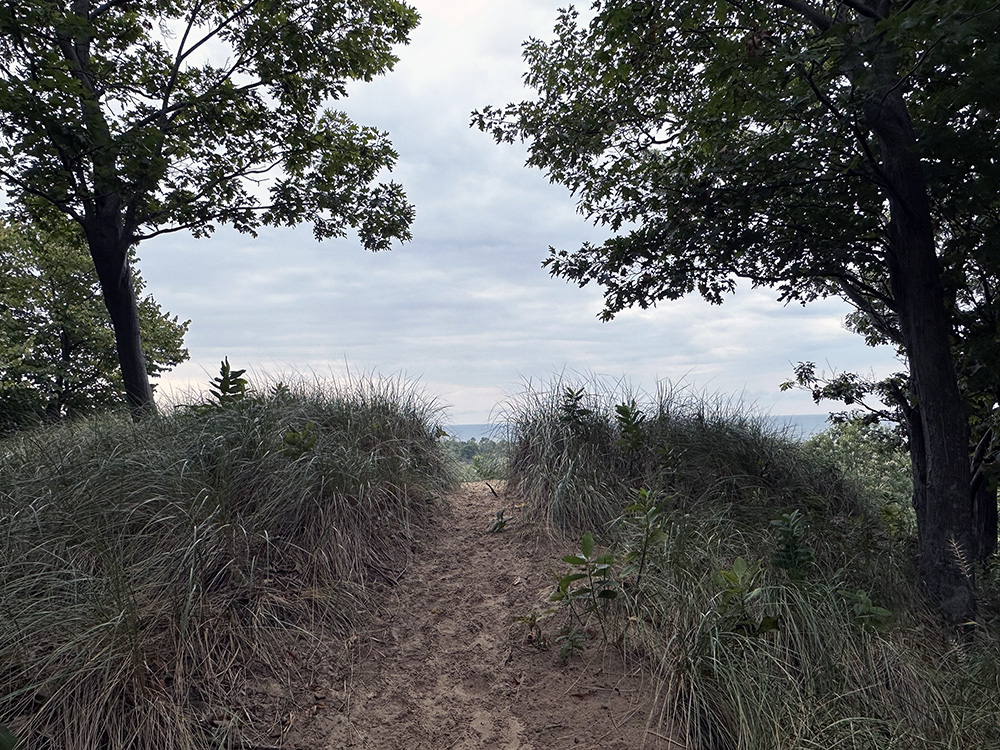
PSi #29, Assemble, June 2024 Call for Contributions, deadline 4/20/2024
On Facilitating: Micro-Practices for a New Gentleness
This essay is my contribution to the SAR 13, Weimar 2022 proceedings, published here on 4/12/2024 in advance of the print edition. Read my text only here.
SIG 8: Facilitating, Fontys Tilburg, NL

SAR forum 2024, April 2024
Announcement + Schedule SIG 8: Facilitating, 4/11/2024
Facilitating as Creative Practice, SAIC
Seminar, School of the Art Institute of Chicago, Spring Semester 2024
The Artist as Facilitator, Universidad Iberoamericana, CDMX
Convocation II, Vienna
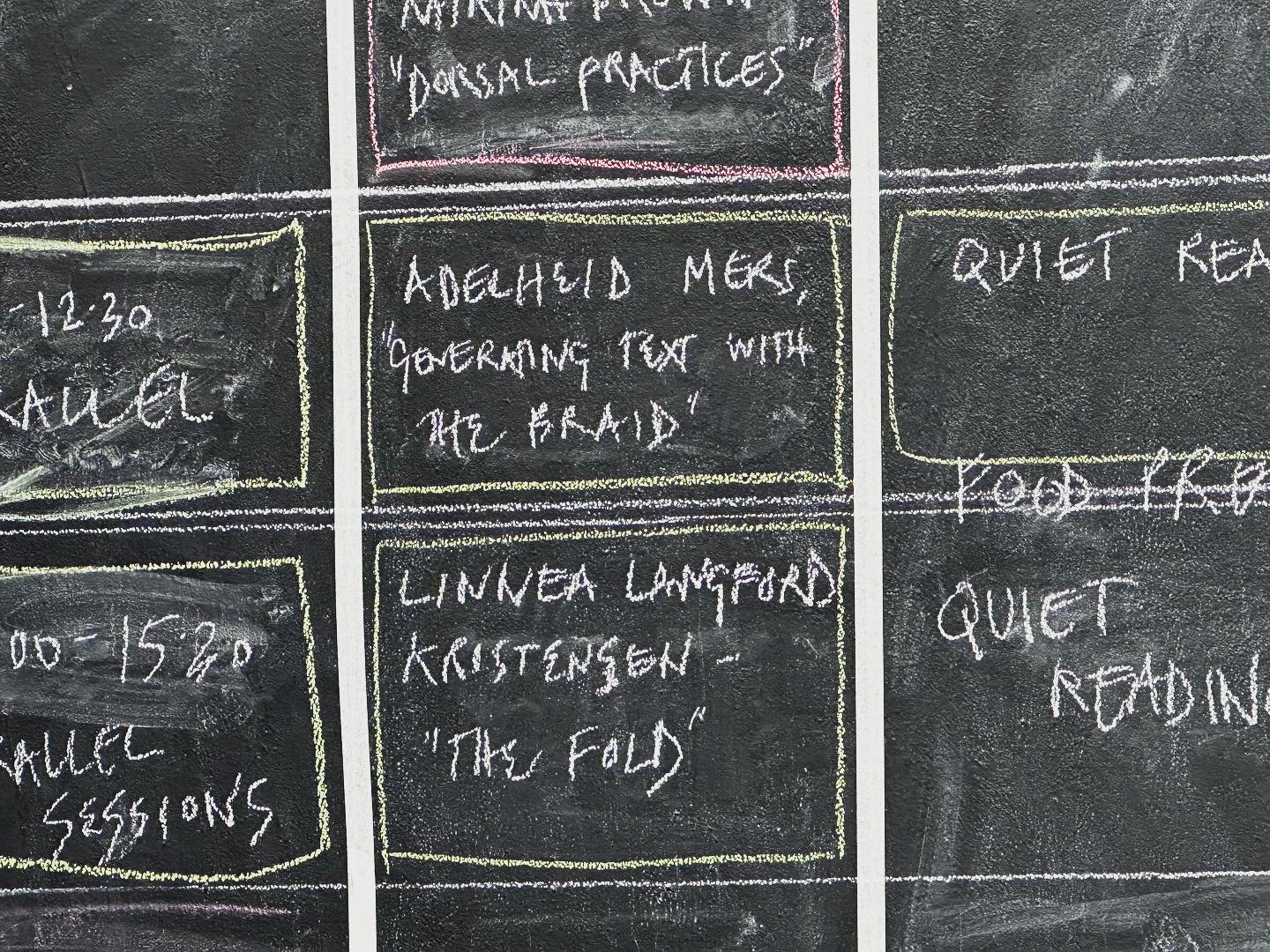
Generating text with The Braid: A workshop
October 3-6, 2023, Convocation II, Zentrum Fokus Forschung, University of Applied Arts Vienna
The Braid is a diagrammatic facilitation instrument that emphasizes thinking in space, through an adjacency of embodied and propositional knowing. It was derived from conversations with experimental musicians and other artists about how they work and is often deployed to facilitate conversations about artistic and other practices. Outcomes may be new thinking about practice, and an impetus toward new work, as used for example with Steve Dutton, in the “Articulating Solitudes” pairing reported on during Affinities and Urgencies in Language-based Artistic Research, 2022. Recently, the facilitation process expanded to also yield entries into new writing. The proposed workshop is to further explore this capacity for collaboratively generating texts from within considerations of the topologies of practice.
Longform 2023
Sept. 2023, Oxbow, Michigan. Braiding with the Longform residency participants, hosted by kg Gnatowski.
How Diagrammatic are Diagrammatic Instruments?
https://doi.org/10.1080/13528165.2022.2224193
in: Andrej Mirčev, ed. Performance Research Volume 27, 2022 – Issue 8: On Diagrams & the Diagrammatic
PSi Working Group Performance and Pedagogy: Walking Talking Listening
 Invitation to participate in September 2023
Invitation to participate in September 2023
The pandemic’s new found facility with technology, as well as an expansion of available platforms, gave rise to a practice of walking and talking remotely among a group of artists and scholars across continents, informally exploring modalities of learning about each other’s ways of sense making while in motion and connected only through sound. What does walking, talking and listening remotely draw from existing pedagogies? How can it inform their expansion? Did related questions form you would like to explore when attending Uhambo Luyazilawula in August 2023?
Following PSi 2023 Uhambo Luyazilawula – embodied wandering practices, and also as part of it, the Working Group Performance and Pedagogy is inviting participants across the globe to meet for paired walks, runs, or rides, traversing any terrain at any length, for any duration, using available sound-based remote communication technologies you are comfortable with. Possible longer term outcomes are a collection of recordings if you chooses to create any, excerpts from transcripts, poetic and other responses to the experience. Our hope is that we will be able to germinate new thinking about communication and learning amidst many ways of meaning making.
AAAE Conference, New York
Hosted by Baruch College / CUNY, New York. See more here.
The Braid – Facilitating the Facilitators
Saturday, June 3, 2023, 1pm – 2pm
This session will introduce an arts-based facilitation practice, The Braid, by sharing its artistic and theoretical context along with an example of its application, followed by a 45 minute, hands-on workshop, and feedback conversation. The Braid’s organizing principle is reflected in its three areas: Power, Publics, Poiesis, or in another alliteration, Managing, Mediating, Making. Unlike solution-centered facilitation methods, the Braid focuses on developing an ecological, institutional imagination from within workshop participants’ intersectional, lived experiences. Institutional imagination is a core component of leadership. The Braid facilitation practice can promote and root participatory leadership approaches. It can be useful for arts organizations, groups of administrators, educators, artists, and arts administration students.
14th SAR International Conference: ‘Too Early / Too Late’
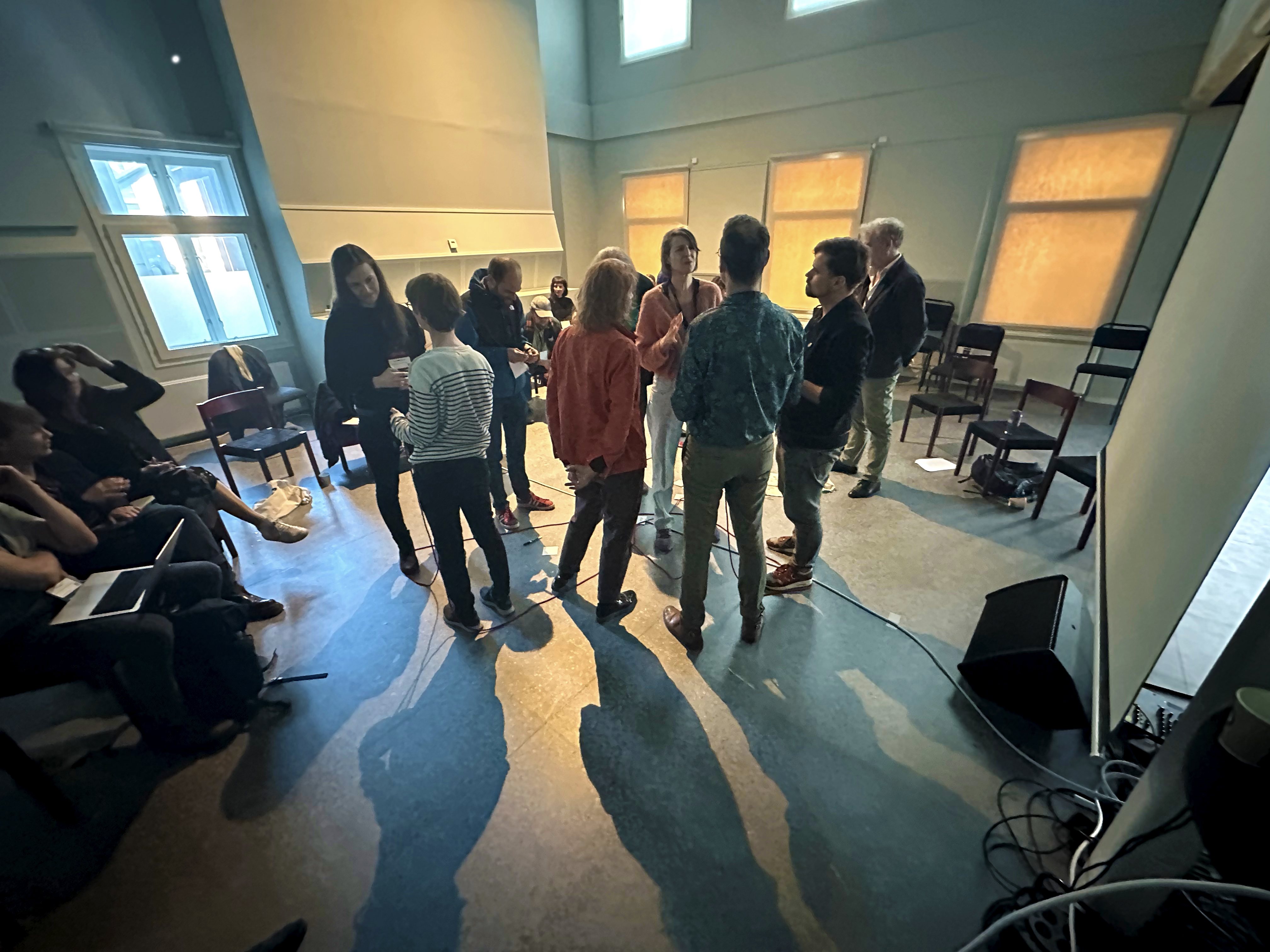
April 19-21, 2023 Program
Norwegian University of Science and Technology, Trondheim
Just right: Performing facilitation as artistic research
EXPO Chicago 2023
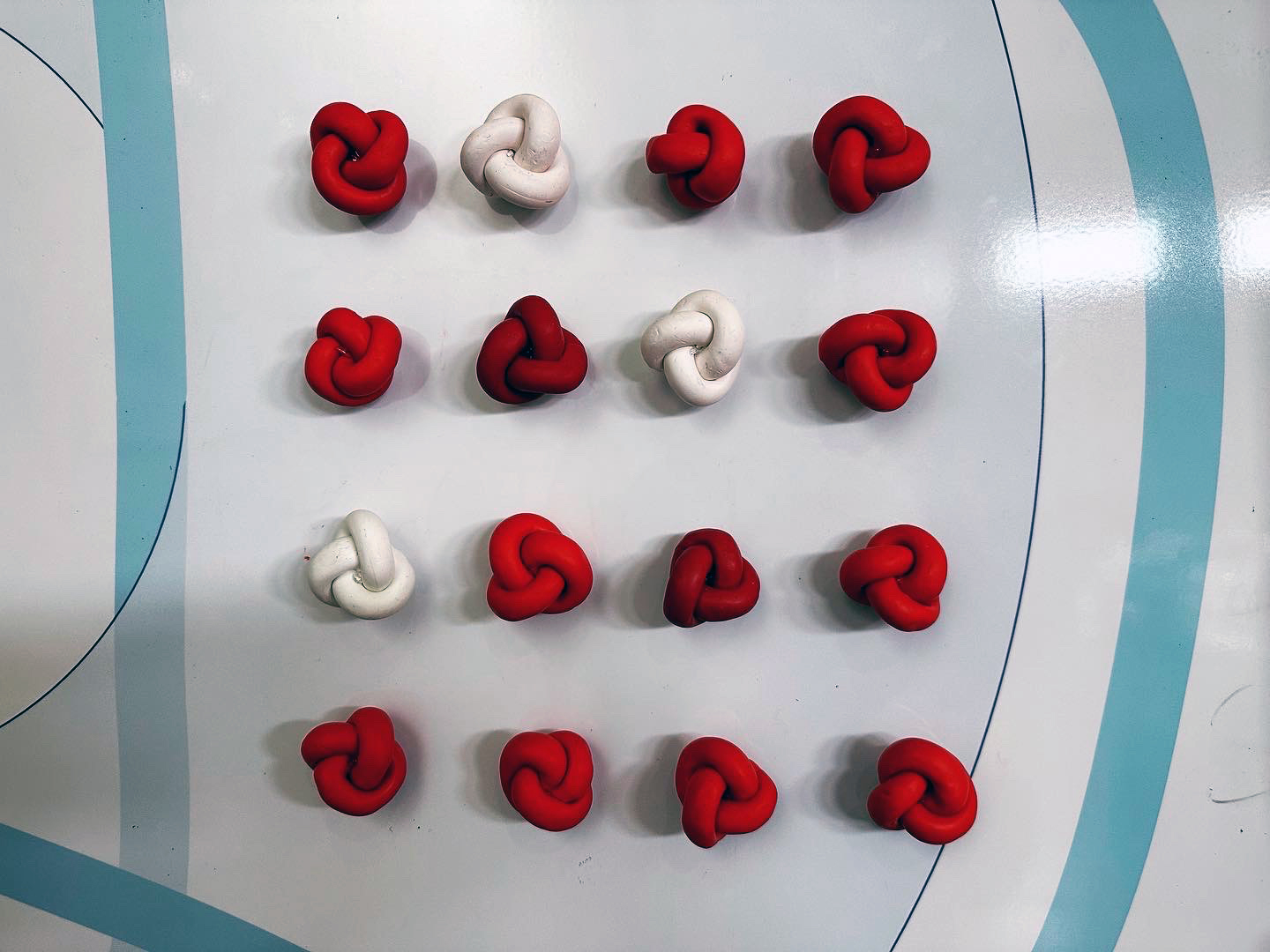 Navy Pier Festival Hall Booth #480
Navy Pier Festival Hall Booth #480
600 E Grand Ave, Chicago IL
April 13 – April 16, 2023
Tria Smith has created streetwear fashions that transform everyday materials from trash to couture. Visitors are invited to harvest and clean plastic waste, and wear the transformed clothes. Adelheid Mers engages visitors in conversations about strategies of circularity, and individual versus collective responsibility. Ideas and actions are recorded onto whiteboards to visualize and capture these ongoing conversations. Lan Tuazon designed the booth walls using Waterbricks, a revolutionary container system for people in need of bulk water and food, that join two deeply interrelated materials of the climate crisis – water and plastic – in secondary use. We invite you to join us in a circular approach, as we reimagine how to innovate and recirculate by simply thinking and acting differently.
The Braid @ New York Arts Program
October 22: The workshop at New York Arts Program was an opportunity to develop an additional aspect of The Braid, using it as a co-writing and writing initiating tool. Over the initial hour, students stepped through The Braid, sharing and validating what they already know about their practices across the dimensions of Making, Mediating and Managing. They then detached the note tiles and in their groups ordered them into a shared narrative. Taking away images of the arrangements can then serve as an opportunity for reflection, and an initial step for further, personal writing.
Call: Performance, Pedagogy, and Co-Presence
Performance Pedagogy Workshop 2022
Convenors: Adelheid Mers & Rumen Rachev
Inspired by the 2022 conference theme of Hunger, the PSi Performance and Pedagogy Working Group will explore what it means for a conference to pose the human and disciplinary challenge to engage in the real world. What does it mean to ‘engage?’
We would like to use the idea of presence to further spin out the questions above. Recently, Alice Lagaay and Anna Seitz (2020) asked about “the role presence could be permitted to play in academic situations of co-presence with others,” including “conferences, seminars or lectures.” We understand that PSi asks to expand this idea, to enact the conference’s co-presence with others in the world.
The idea of presence will be investigated through the notion of translinearity; that is, as “performative forms of research, teaching and learning that cannot easily be transferred into linearized formats” (Holkenbrink & Seitz, 2018). What forms of dialogues can arise from co-presence within academia and beyond the walls of the institution? How can we listen in the context of a dialogue? Which forms of action might that produce?
We are seeking prompts, ideas and/or suggestions to sharpen the topic, its attendant unease and contradictions, along with long-awaited opportunities and excitement, for discussion and/or presentation at three sessions the Working Group will host online. Please write to us at by July 15th and we will collate/curate sessions around your prompts. Contact email in link.
We will convene online:
23rd of July, 7 – 8 pm CDT
30th of July, 2 – 3 pm CDT
6th of August, 7 – 8 pm CDT
13th SAR International Conference 2022


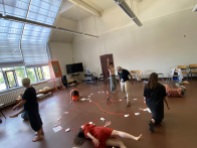
I presented a workshop, ‘Micro-practices for a New Gentleness’ and gave a brief introduction to work jointly done with Steve Dutton, at the Gathering for the Special Interest Group, Language-based Artistic Research.
1. Respectful, detailed, ethical engagements: Facilitating ‘Micro-practices for a New Gentleness’
Saturday, 2 July 2022 10:00 am
In “The Three Ecologies” Guattari asked to “organize new micropolitical and microsocial practices, new solidarities, a new gentleness, together with new aesthetic and new analytic practices.” I am inviting conference attendees to join me in a facilitated conversation, as part of my recent project, ‘Micro-practices for a New Gentleness’. The project was developed by probing conventions of studio critique and conversational improvisation for constructive patterns. We will use a set of 18, largely participant-administrated prompts, supported by associated 3-d printed figurines. As an immigrant, who has lived in a host country for many years, I am interested in centering epistemic diversity. Not the proverbial ‘melting pot’ is ever the outcome of living together, but a series of patterns by which, as Karen Barad states “differences that make a difference” appear, as part of “respectful, detailed, ethical engagements.”
Friday 1 July 2022
Indeterminacy Festival – Braiding across disciplines, April 25-30, 2022
Workshops are underway in Malta, Montreal, Buffalo, and Chicago. Here are a few images from the third day, with the workshop “Where the Music is, and how to do it there”, led by Ben Zucker and hosted in my studio.
Since 2016, Stanzi Vaubel has directed the annual Indeterminacy Festival, offering curated, arts-based laboratories that challenge participants to connect across disciplinary expertise. The 2022 iteration of the Indeterminacy Festival: Re-Disciplining in the 21st Century is being created in collaboration with Adelheid Mers, using The Braid, a multi-dimensional facilitation instrument Mers has developed, as a point of departure. Our goal was to support a line-up of facilitated workshops, each developed from within our contributor’s artistic practices. The Indeterminacy Festival was invited by the School of Performing Arts at the University of Malta. It is taking place there, and at satellite locations, in April 2022.
Expo Chicago, April 7-10, 2022
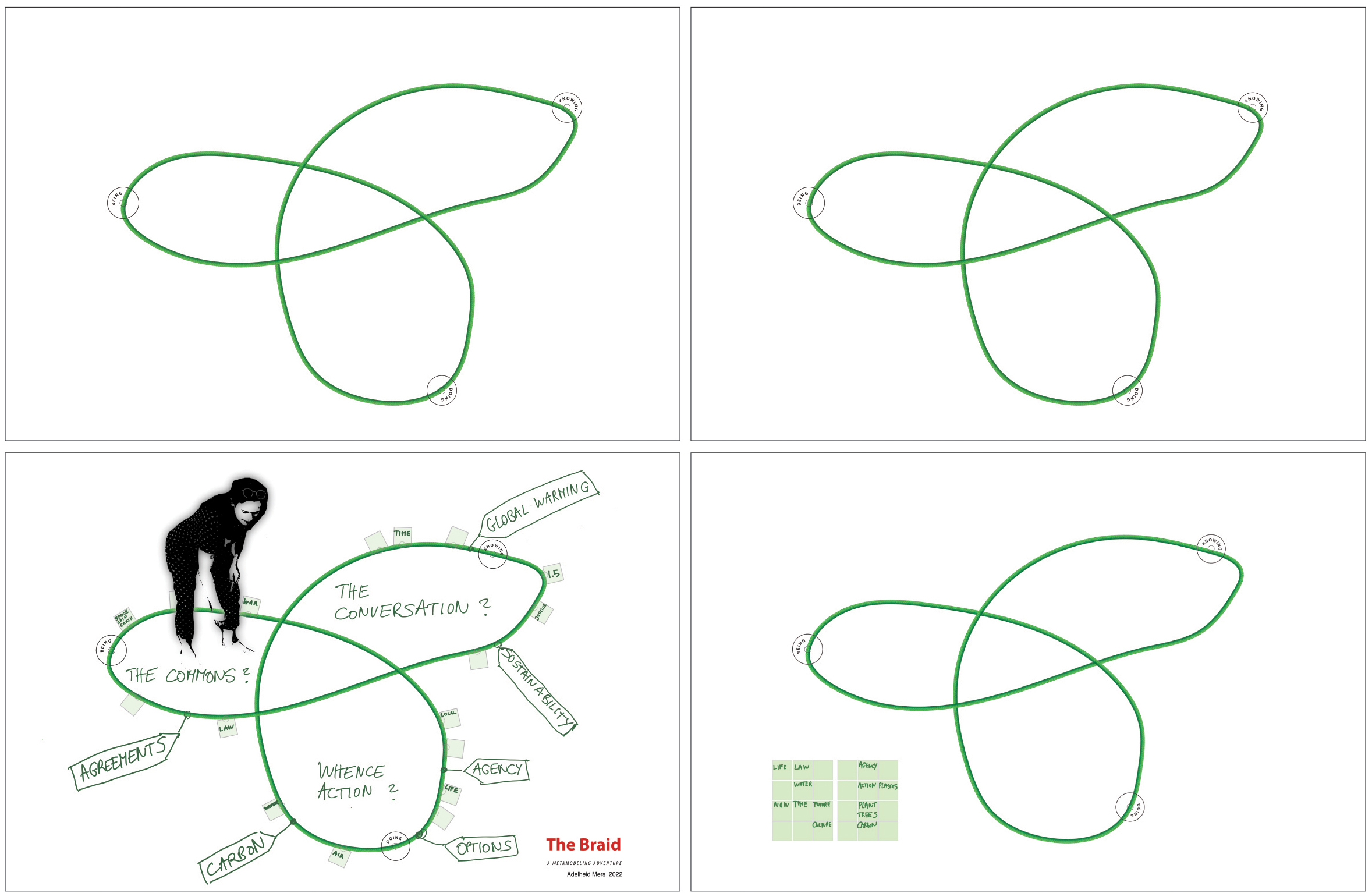
These whiteboards will be at the 6018 North “Sustaining” exhibit at Expo Chicago (Booth 455), ready to braid questions and personal approaches to climate justice and action. Here are some materials: Project Drawdown, Julie’s Bicycle, Sara Lazarovic’s comic “Drawing a Path to Action“, IPCC, COP26, Chicago 2022 Climate Action Plan, The Helen Frankenthaler Climate Initiative.
Update: Here are images taken over the four days of conversations. Artists considered sustainability of careers and materials. Sustainability consultants, non-profit leaders, entrepreneurs and developers reflected on or simply shared communication and investment strategies and business models. New ideas were sparked as well.
Spring 2022
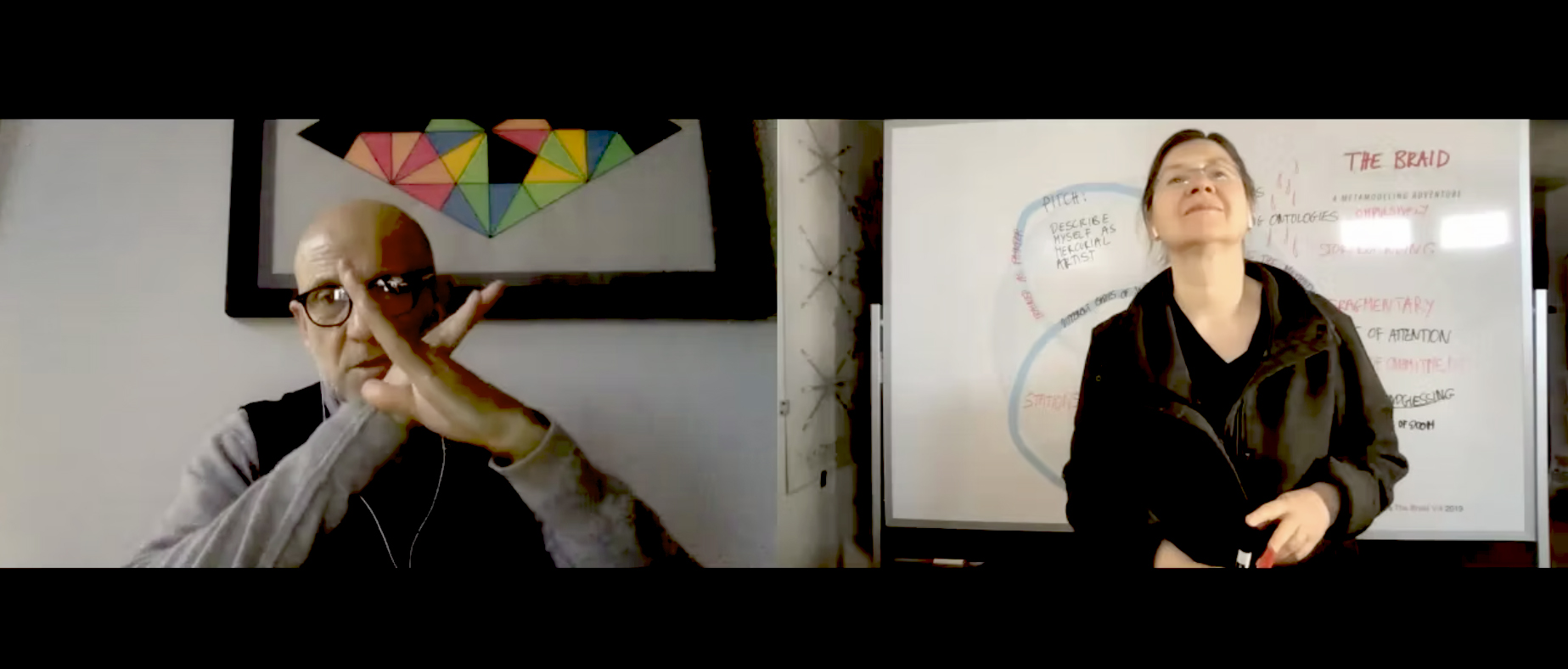
In February, I’ll be in conversation with artist and curator Steve Dutton, as part of Affinities + Urgencies in Language-based Artistic Research (PART II), facilitated using The Braid. I will speak about Performative Diagrammatics at a symposium, Art as Education and Education as Art, held at Chapel Arts Studio, UK. A Micro-practices for a New Gentleness workshop is scheduled to take place with the ARTexchange program of the College Art Association Conference in Chicago, which has pivoted online. In June (just postponed from April), I’ll contribute a Micro-practices for a New Gentleness session to the SAR symposium at the Bauhaus University Weimar. I’ve been invited to develop a piece on Diagrammatic Instruments as generative ‘middle terms’ for the Journal for Performance Research, for an issue On Diagrams and the Diagrammatic. The University of Music and Performing Arts in Vienna is supporting new work on “Intra-view digital”, with Doris Ingrisch. In preparation is a Symposium at the University of Malta, in collaboration with Stanzi Vaubel, developing personal facilitation modules with 30 artists and scholars, to take place on-line in April, with in-person satellite events in Chicago, Montreal and Buffalo, NY.
The Braid Kit: Facilitating a faculty retreat at GVSU
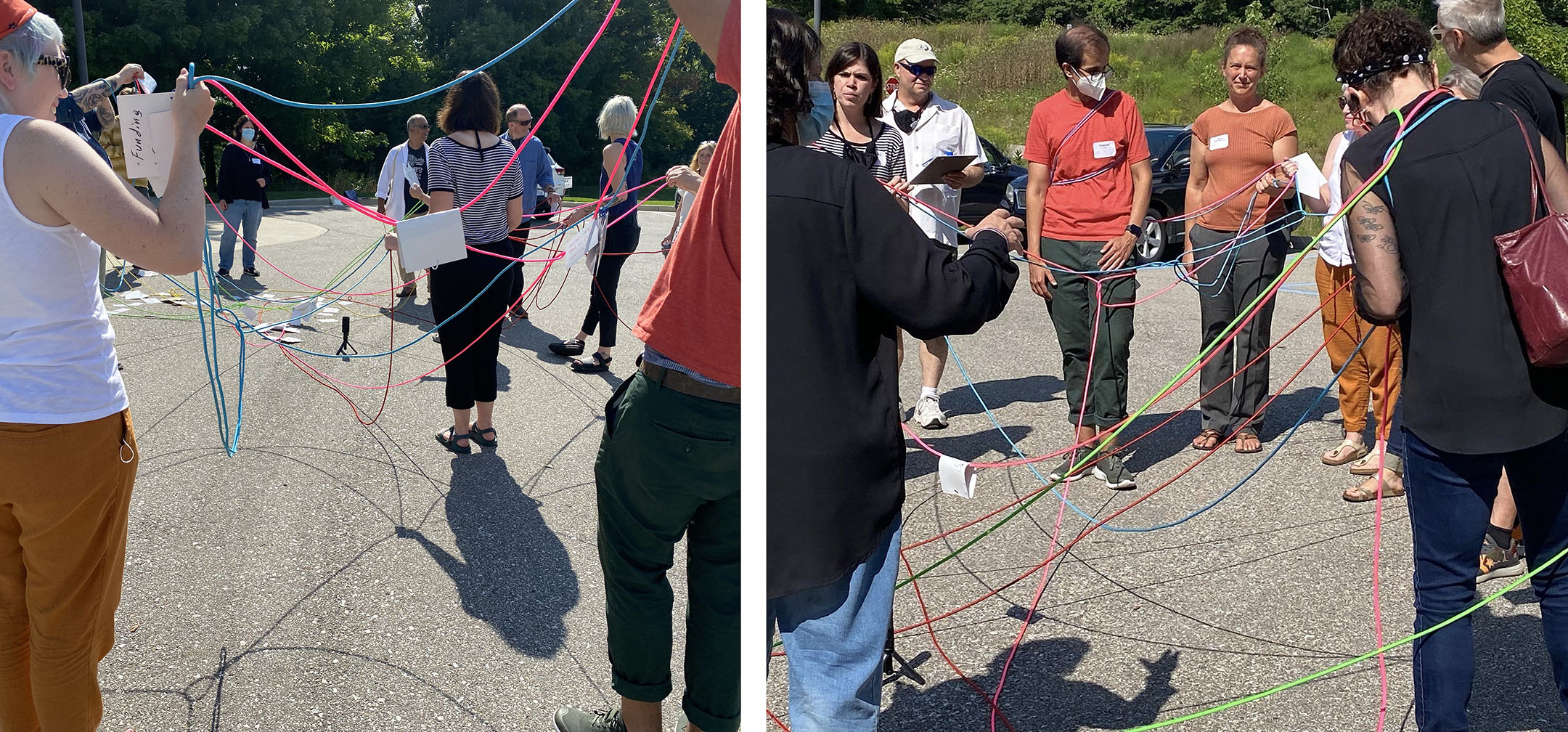 August 2021 – Over two days, I facilitated a retreat at Grand Ravines Park in Michigan, for the Visual and Media Arts Department of Grand Valley State University. Faculty, staff and alumni participated. Invited and supported by department chair Paul Wittenbraker, I worked closely with Jenn Schaub, an alum of the program and the Director of Community Building & Engagement at the Dwelling Place of Grand Rapids. Goals were bringing everyone together after a reorganization to assess and reconnect, and visioning future scenarios. Starting with Braid diagram supported conversations about participants’ own, creative practices, we moved on to using String Braids in reflecting on each area’s curriculum and pedagogy, followed by exploring connecting narratives that can collectively move forward Art History, Art Education, Visual Studies, and multiple Fine Arts, Design and Production specialties.
August 2021 – Over two days, I facilitated a retreat at Grand Ravines Park in Michigan, for the Visual and Media Arts Department of Grand Valley State University. Faculty, staff and alumni participated. Invited and supported by department chair Paul Wittenbraker, I worked closely with Jenn Schaub, an alum of the program and the Director of Community Building & Engagement at the Dwelling Place of Grand Rapids. Goals were bringing everyone together after a reorganization to assess and reconnect, and visioning future scenarios. Starting with Braid diagram supported conversations about participants’ own, creative practices, we moved on to using String Braids in reflecting on each area’s curriculum and pedagogy, followed by exploring connecting narratives that can collectively move forward Art History, Art Education, Visual Studies, and multiple Fine Arts, Design and Production specialties.
CSPA Quarterly – Q33: “For a New Gentleness”
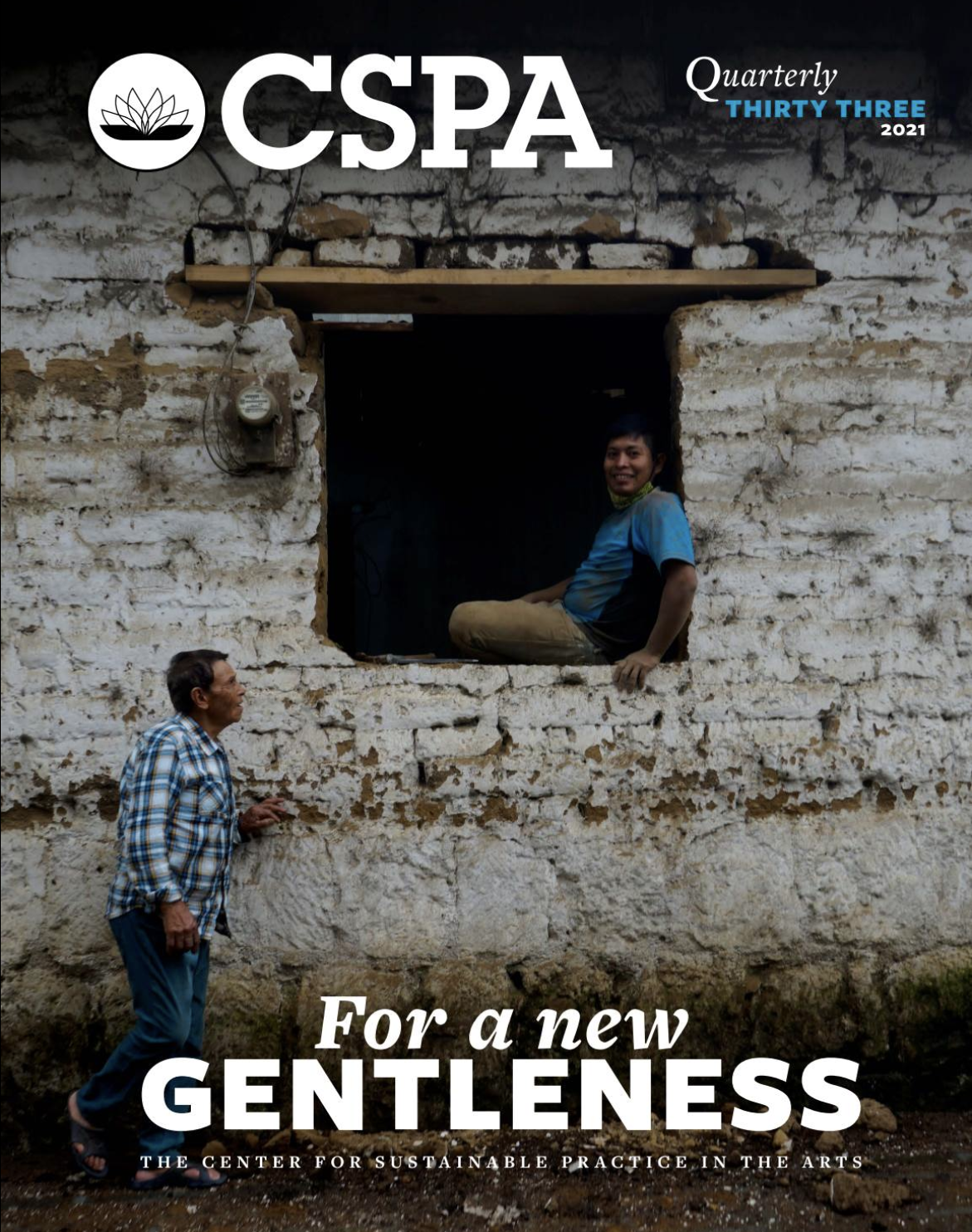
July 2021 – Co-edited with Daniel Jiménez Quiroz, and stewarded by Meghan Moe Beitiks, CSPA Quarterly – Q33: “For a New Gentleness” is live today, with essays by María Iñigo Clavo and Benvenuto Chavajay Ixtetelá, Alejandro Ponce de Leó, Işıl Eğrikavuk, Tyanif Rico Rodríguez on Manuela Infante, and Juan Pablo Pacheco Bejarano. Get it here.
“Performative Topologies – small gestures from within”
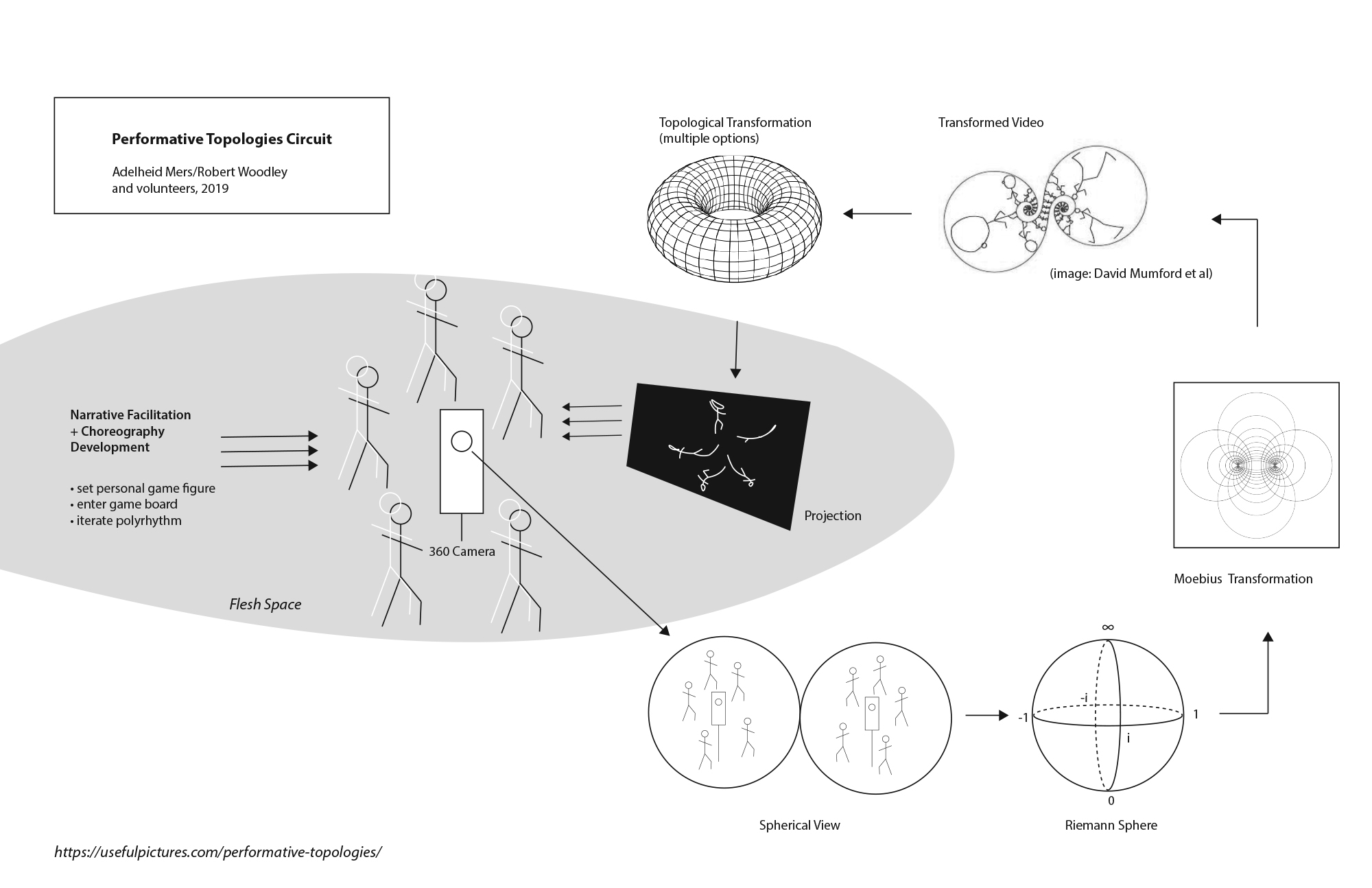
July 2021 – My text, “Performative Topologies”, is part of the Special Issue Flesh Circuits edited by Connor Mcgarrigle and El Putnam for the International Journal of Performance Arts and Digital Media.
“Performative Diagrammatics: An Artistic Exploration of the Relation Between Epistemic Diversity and Systemic Elasticity”
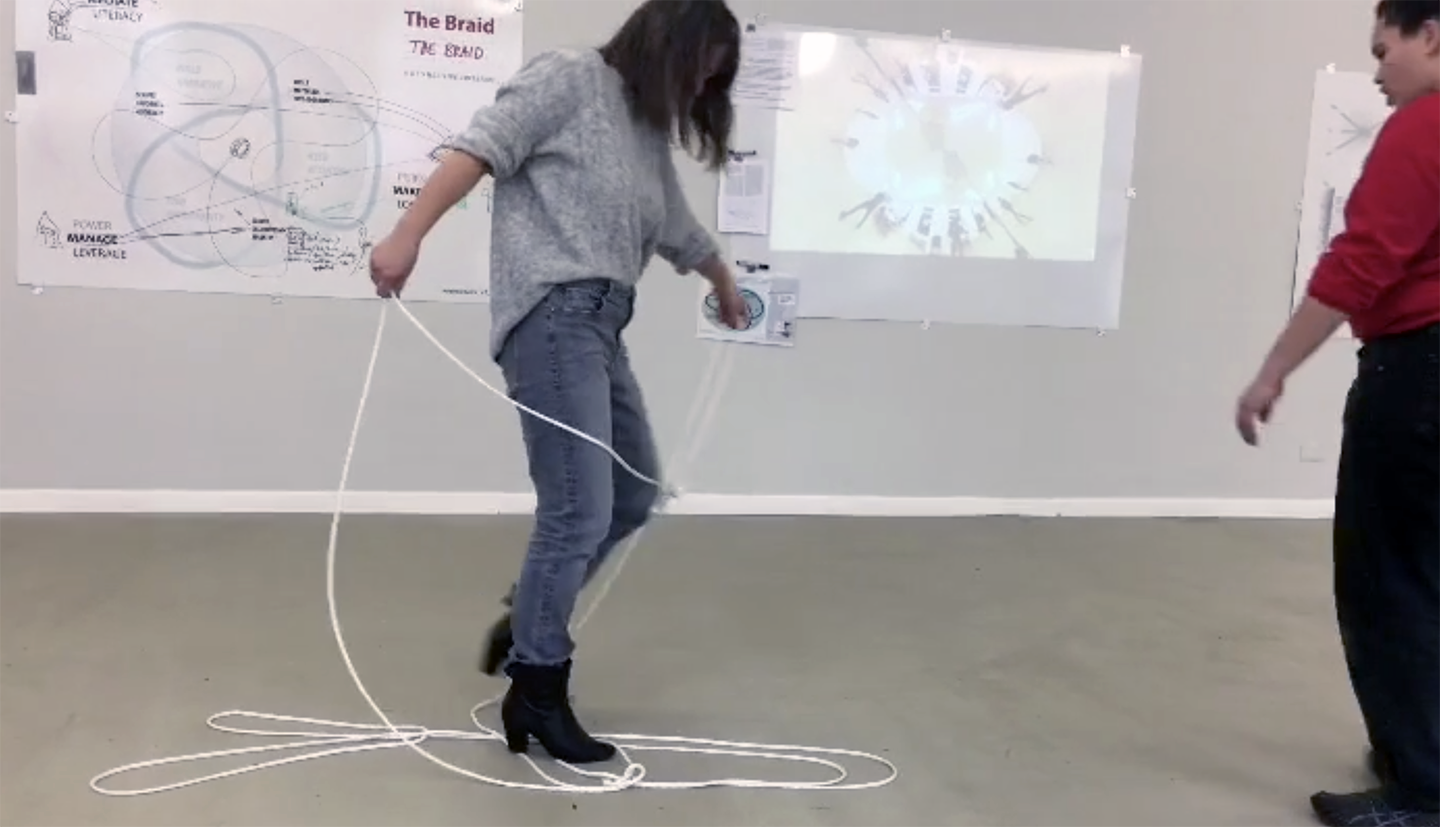
June 2021 – GPS 4.1 is out, an online, peer-reviewed journal, including my essay about The Braid and Performative Topologies. I am very excited about the ability to include video clips in the body of the text.
Illinois Arts Council Fellowship
May 5, 2021. I am happy to share that I was awarded an Illinois Arts Council Fellowship, in the category of Performance-based Art, New Performance Forms.
Performance Studies international – Constellate
In June and July 2021, the newly formed PSi Working Group Performance & Pedagogy will convene two sets of three online workshops as part of the Constellate events, to investigate permutations of the question how knowing in performing shapes performance pedagogies and the institutions that house and deploy them. You can find out more here.
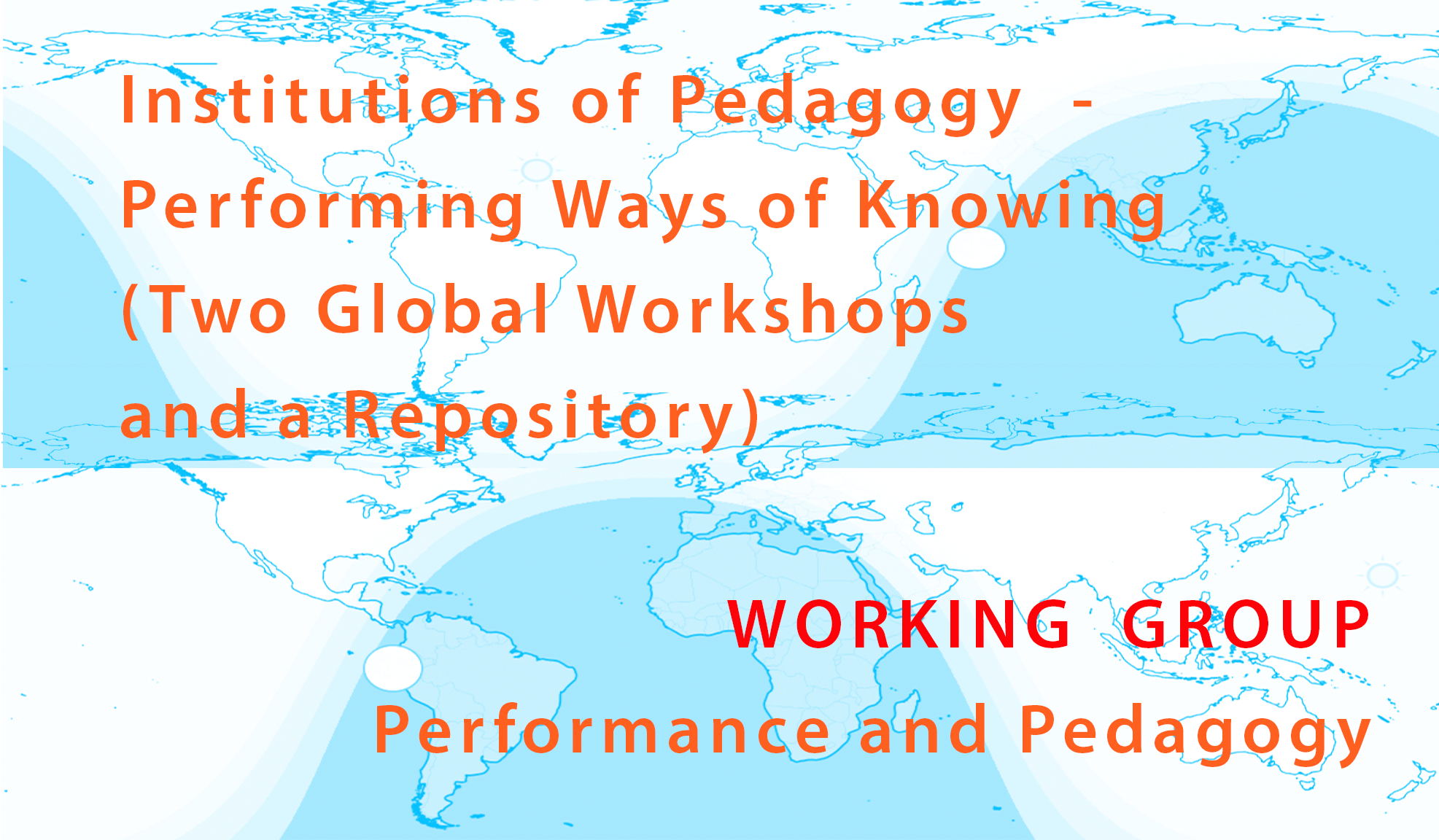
On August 13., 14., and 15., as part of the “Neighbourhoods” stream of PSi Constellate, there will be three opportunities to explore “Micro-Practices for a New Gentleness”, through an online Performative Diagrammatics Lab. The full Constellate line-up is here.
Update: here is documentation of the event.
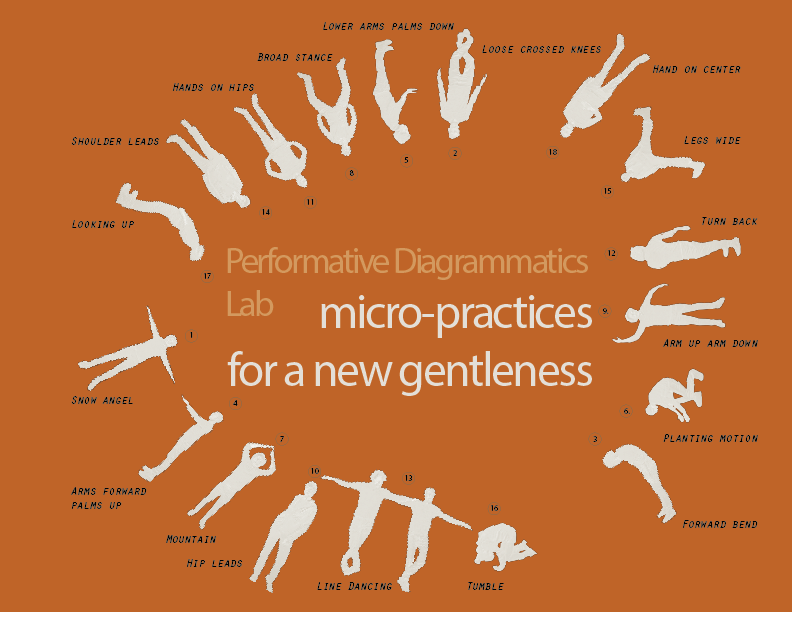
“The Braid: Moving Across Dimensions from Representation to Performativity”
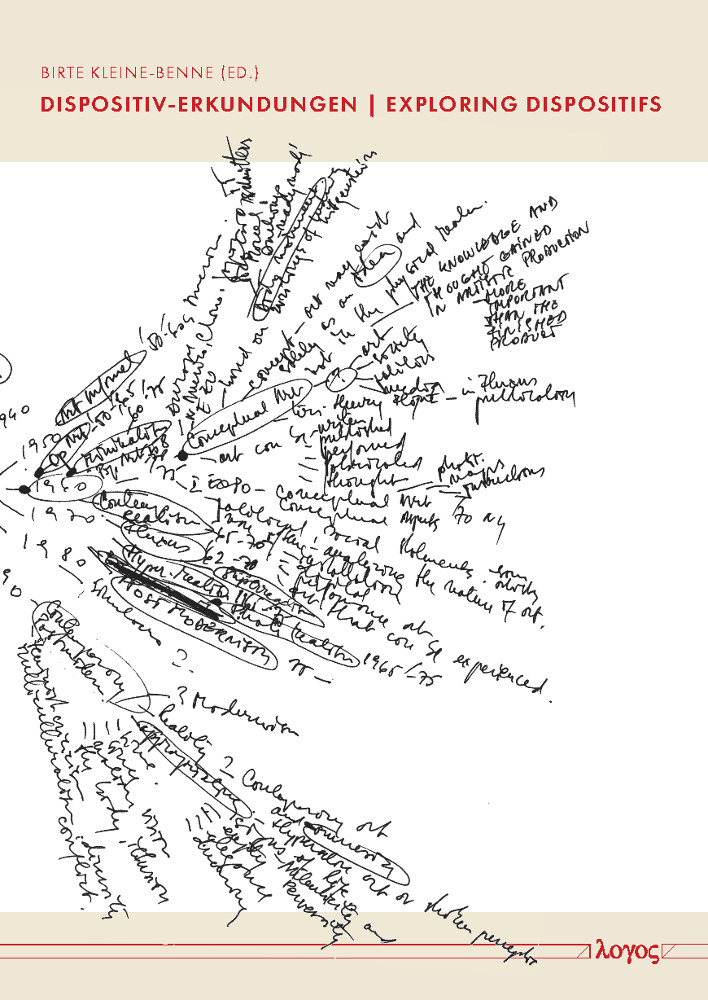
Practice Sharing: “The Braid” + “Performative Topologies”
December 2020: I am happy to share that I contributed to Practice Sharing — an online presentation of expanded approaches to language-based practice within the field of artistic research
Practice Sharing is now launched — an online presentation of expanded approaches to language-based practice within the field of artistic research. Over 70 individuals and collaborations are included in this first ‘sharing’: See https://www.researchcatalogue.net/view/835089/1021562
The intent has been to reflect on how language-based artistic research is practised in its diversity rather than to define or determine. As such, the focus on language within artistic research is considered from a broad and transforming perspective to include diverse fields such as visual arts, performance, film, theatre, music, choreography as well as literature; where language-based practices might include (as well as move beyond) different approaches to writing, reading, speaking, listening.
Contributors were invited to respond to an open ‘call’ outlining their specific approach with one or two examples from their own artistic- or practice-based research — focusing on specific language-based ‘practices’. The 70 chosen submissions have been ordered alphabetically such that the reader may search by name or explore each contribution within the immediate vicinity of other contributions to allow for chance acquaintances, unexpected resonances and aleatory connections.
Rather than a definitive or exhaustive archive or survey of the field, this exposition hopefully provides a starting point from which future conversations and collaborations might emerge.
Practice Sharing will continue to evolve through future calls and contributions. Conceived and co-organised by Emma Cocker, Alexander Damianisch, Cordula Daus and Lena Séraphin, this Special Interest Group (SIG) in Language-based Artistic Research* is part of an initiative of the Society for Artistic Research which provides contexts for coming together via the exchange of language-based research.
For updates, feel free to subscribe to our newsletter by following this link.
The Braid as structuring device in Art, Engagement and Economy
Throughout an online book, Art, Engagement and Economy, produced in 2020 as part of a fellowship at Moore College of Art and Design, Caroline Woolard uses The Braid’s sections – make, mediate, manage – as a structuring element, and explains why in an introductory section.
The Braid at the HPAC Gala
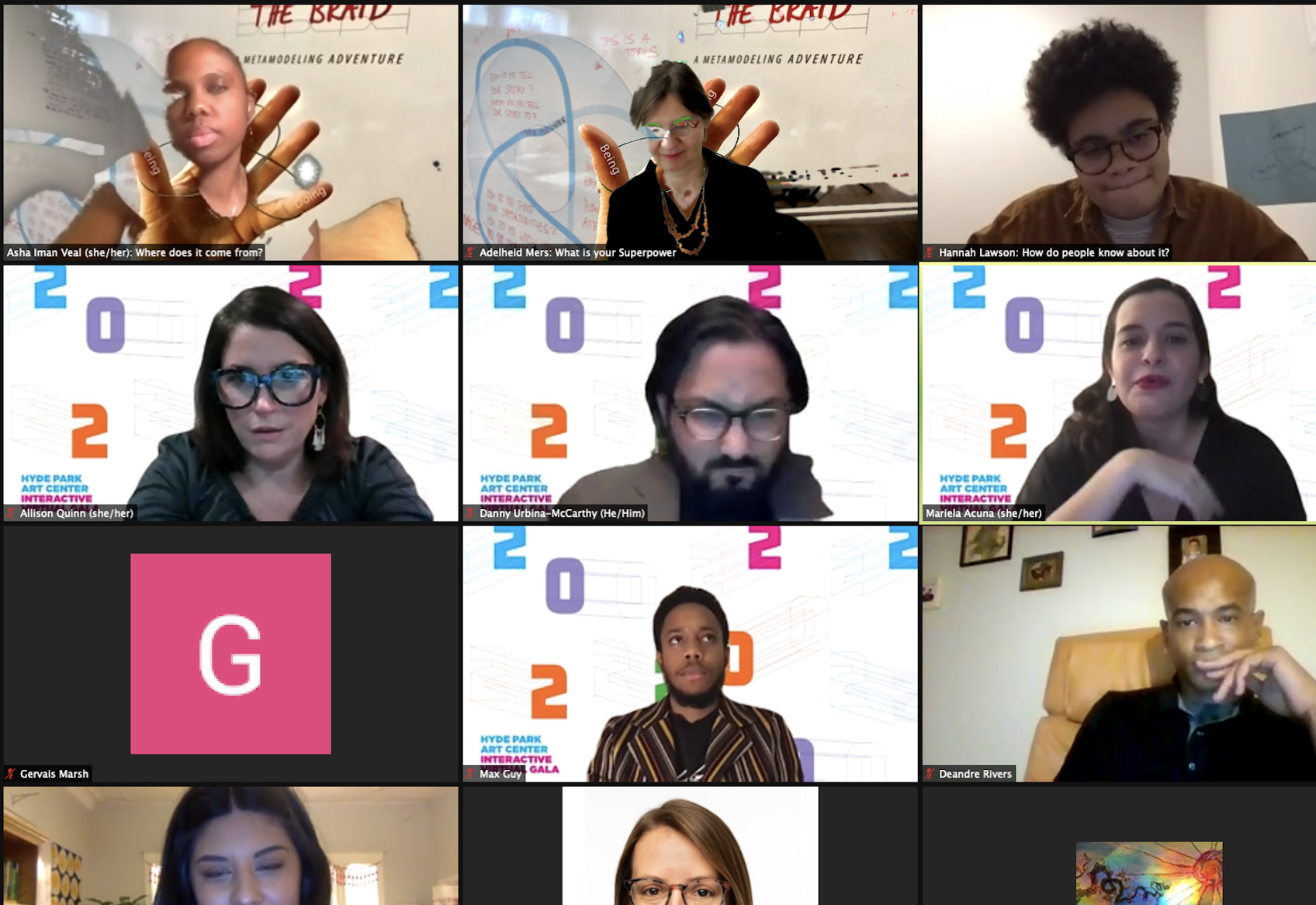
November 2020. With Asha Iman Veal and Hannah Lawson, The Braid is available as a virtual engagement at the Hyde Park Art Center Gala.
2020: postponed, in progress, publishing
2020 has seen conferences, workshops, and residencies postponed, and this cycle is continuing into the first half of 2021. The Performance Studies international conference in Rijeka, at which we had intended to newly convene the Performance and Pedagogy group I now co-lead, was postponed and is expected to be virtual next summer. A Micro-practices for a New Gentleness workshop and a paper on this most recent work were also invited to be part of one of the conference streams. A teaching assignment at the Bauhaus University Weimar, the third in a series and also intended to continue work on Micro-practices for a New Gentleness, may need to be postponed a second time.
This year, chairing my department at the School of the Art Institute since May has been almost all-consuming, but it also is work I love to do. When I was developing a program in Digital Arts Administration during my last round as a chair (that was not realized at the time), I did not anticipate we would all be digital arts administrators now.
At the same time, writing projects emerged and are now variously in press, nearing completion, and in review. With Daniel Quiroz, I am co-editing an issue of CSPA-Quarterly, called A New Gentleness, and I thank Moe Beitiks for the invitation. It allows me to see how (much) we ask of each other from yet another perspective. An essay about The Braid is part of a book that has grown to include contributions in German and English, Dispositiv-Erkundungen, jetzt, (‘Dispositif’ explorations, now) edited by Birte Kleine-Benne and Elke Bippus. I am telling the story of The Braid’s emergence from my (faulty) diagram of Karen Barad’s “Posthumanist Performativity”, becoming a diagrammatic instrument that opened the doors to understanding performance as part of my work, eventually posing a challenge to perform a transition between world views. A text about discovering Vilem Flusser’s writing, called Stalking the Continuum, will be republished in an Anthology, Understanding Flusser: Understanding Modernism, edited by Aaron Jaffe, Michael F. Miller, and Rodrigo Martini. Two more texts, about Performative Diagrammatics and Performative Topologies, are in various stages of peer review.
A multi-year grant I was a co-applicant for was awarded to my colleagues in Canada by the Social Sciences and Humanities Research Council. They are working on Cultural Mapping the Opioid Crisis in Small Cities in British Columbia, and I look forward to contributing in time.
Workshop: Micro-practices for a New Gentleness
1:00 – 2:00, Saturday, January 25, 2020. Index Art Book Fair, Mexico City. “Micro-practices for a New Gentleness” is a prototype-stage co-creation workshop, developed in Chicago by a constellation of international and interdisciplinary collaborators with art, design, music, and mediation backgrounds.
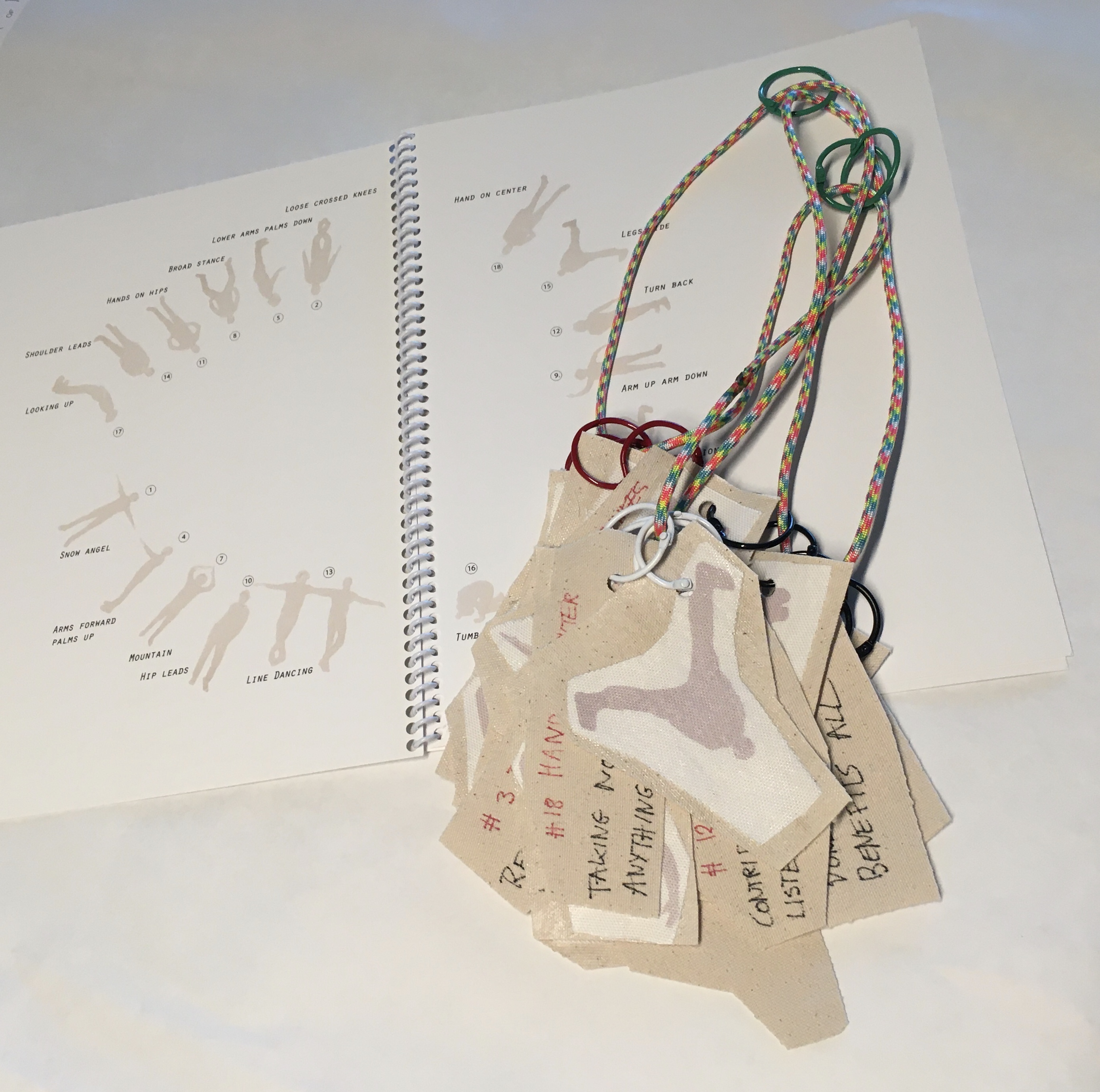
The facilitation instrument is a hybrid, multiple-publishable object. A small number of copies will be available at the Index Art Book FairJanuary 23-26, 2020.
Organizer Adelheid Mers is bringing to the Index Art Book Fair a facilitation instrument that aims to bring meta-communication into play through talk mixed with choreographic, full-body gestures. This is only the second public presentation of this material, after the workshop at the Vilém Flusser Archive in Berlin earlier this month. Your participation and input are invited.
Meet the Chicago 400: Lessons in the Carceral State
January 21, 2020, The Drawing Center, New York
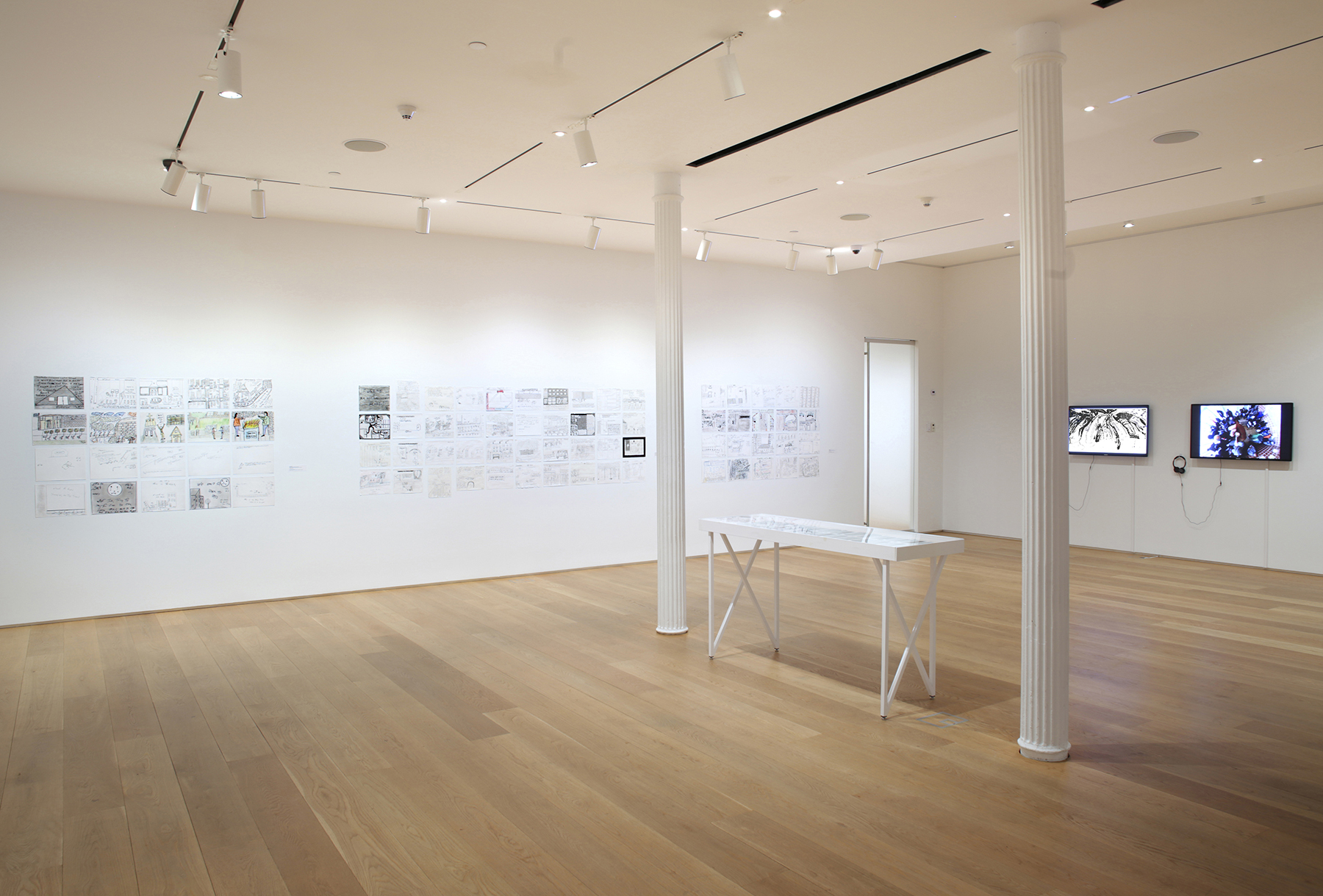
In fall 2019, while I participated in the Faculty Projects show at the Sullivan Galleries, Laurie Jo Reynolds reached out and initiated a conversation about creating a systematic overview of her ongoing advocacy project, The Chicago 400, which addresses the bureaucratic complexities released sex offenders experiencing homelessness in Chicago encounter as they are obligated to weekly register with police. Laurie Jo also invited me to envision art work, specifically videos. Diagram and two video works were shown as part of the Drawing Center’s exhibition, Meet the Chicago 400: Lessons in the Carceral State.

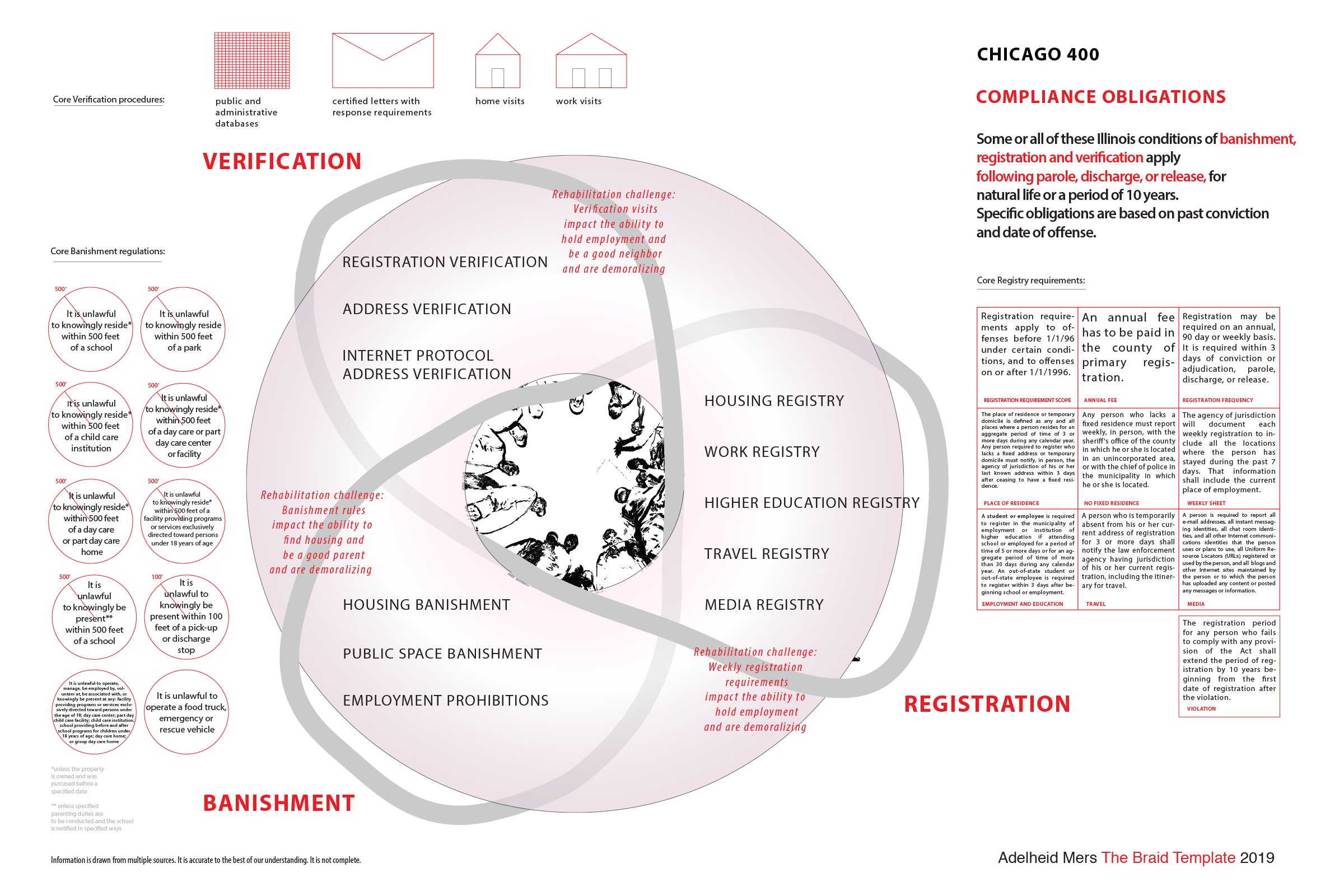
Workshop: Micro-practices for a New Gentleness
Saturday, January 18, 2020. In the frames of Vorspiel / transmediale & CTM programme, the Vilém Flusser Archive presents the workshop “Micro-practices for a New Gentleness” by Adelheid Mers (Performative Diagrammatics Laboratory)
 Organizer Adelheid Mers is bringing to the Flusser Archive a prototype of a facilitation instrument that aims to bring metacommunication into play through talk mixed with choreographic, full-body gestures. Following a brief, introductory explanation, your participation and input in a facilitated interaction are desired. Together, we may gain insights into how conversation works. In German, English, and any language you may contribute. All abilities welcome. Attendance limit 15. Please register via info@flusser-archive.org
Organizer Adelheid Mers is bringing to the Flusser Archive a prototype of a facilitation instrument that aims to bring metacommunication into play through talk mixed with choreographic, full-body gestures. Following a brief, introductory explanation, your participation and input in a facilitated interaction are desired. Together, we may gain insights into how conversation works. In German, English, and any language you may contribute. All abilities welcome. Attendance limit 15. Please register via info@flusser-archive.org
Exhibition and Workshops: Performative Diagrammatics Lab at Sullivan Galleries/w Saturday Club
August 28 – October 19, 2019
Performative Topologies and THE BRAID are included in the SAIC Faculty Projects Exhibition. Performative Topologies will be enacted at the reception, September 20. THE BRAID will be available for activation with classes Wednesdays through Fridays, during gallery hours.
The Performative Diagrammatics Lab adapts to site. As part of this iteration, I will hold two, six-session Saturday workshop sequences, the Saturday Club. The workshops revolve around the following questions: 1. How to develop a tangible Crit Kit, and 2. How to devise Embodied Reading Tactics. Both questions address teaching as radical possibility. Dates are September 14, 21, 28, and October 5, 12, and 19. Please get in touch if you are interest in joining a workshop.

In the Studio
August 2019
Enacting critique and enacting critical/affirmative methods in a conversation on leadership with Gerda Müller, Vice Rectorate for Organisational Development, Gender & Diversity, University of Music and Performing Arts, Vienna.
Conference Workshop: The Braid at PSI25
July 2019
THE BRAID will be activated in a workshop at PSI25, Calgary, Canada. Read the description.
Missing Scenes Workshop. Goat Island Archive.
June 2019
I spent three days with curator Nick Lowe, Sarah Skaggs and others, discovering fractal responses to the responses and the concept of the exhibition: “Goat Island Archive – we have discovered the performance by making it.” 
Wege Projekt
March 2019. Presented at the University of Music and Performing Arts Vienna, the Wege Projekt, collectively organized by Doris Ingrisch, Andrea Sodomka and Florian Tanzer, shares conversations with interdisciplinary artists and performers. The project is summarized in a video on the page linked above (in German). The screenshot below shows a collage of work I addressed when being interviewed.

Code Movement Workshop
May 2019
I am heading to New York for three weekends in May, participating in The School for Poetic Computing Code Movement workshop. This is session 1/3, in Nancy Meehan’s studio. Here are short video clips from the second meeting.

Exhibition: Membrane
March 7, 2019 – April 20, 2019
With Jörg Brinkmann, Ursula Damm, Adelheid Mers, Rachel Smith, Moritz Wehrmann. Kunstverein Tiergarten|Galerie Nord, Turmstr. 75, Berlin.
Opening: 7 pm, March 7, 2019 (German Info)
On view will be The Braid and Fractal-3-Line Matrix Whiteboards and related video documentation, and new Performative Topologies video work, developed with Robert Woodley. Performative Topologies were created in Chicago with Joseph Lefthand, Vero D. Orozco, Caroline Kawen Ng and other contributors, and with a group of students at the Bauhaus University Weimar.
You are invited to join us at these workshops:
Saturday, 3.9., 5–7 pm: Performative Topologies, with Adelheid Mers, Joseph Lefthand, Vero D. Orozco and Caroline Kawen Ng
Thursday, 3.14., 5–7 pm: The Braid, with Adelheid Mers
Friday, 3.15., 5–7 pm: Performative Topologies, with Adelheid Mers
Thursday, 3.21. 5–7 pm: Fractal 3-Line Matrix, with Adelheid Mers
Friday, 3.22., 5–7 pm: Performative Topologies, with Adelheid Mers
Friday, 4.5., 5–7 pm: Performative Topologies, with Sarah Hermanutz and Ruo-Jin Yen
Tuesday, April 16., 5–7 pm: Performative Topologies, with Maud Canisius and Sarah Hermanutz
About workshops:
Adelheid Mers’ diagrammatic templates are greatly condensed texts and conversations. Simultaneously they contain the invitation to unfold them performatively, experimentally and playfully. This is why workshops are a central part of this exhibition. Visitors will be introduced to the diagrams and invited to actively engage them.
Three workshop modules will be offered. The Fractal 3-Line Matrix is a two-dimensional tool that visualizes non-hierarchical forms of text interpretation. In the workshop we will probe the template’s multiple functions, using an example text. Participants will learn to implement and also adapt the methods contained in the matrix.
The module using the three-dimensional Braid template invites participants to synergistically assess conditions that impact their own professional practices. Participants from the cultural sector, for example artists, designers, theorists or administrators, may ideally work in rotating pairs, to gain and share new insights by comparing and inscribing their experiences into the Braid template.
The workshop module Performative Topologies is conceptualized as a game and movement lab. Differently from the preceding two workshops the initial engagement here is through a verbally shared algorithm. This module asks how the presentation of an imagined object under alternating perspectives (for example imagining, describing, sketching, performing) promotes a new understanding of one’s own ways to value personal experience. This module will culminate in a joint performance – a spatial diagram of sorts.
By contributing to a workshop, participants both support the artist in her ongoing research into Performative Diagrammatics and gain the opportunity to explore and share what often tends to be backgrounded in daily work and life – own ways of perceiving, valuing, thinking and representing.
Workshops take place in German and English. Participation is free.
Study Center for Groupwork: Video
March 2019
Talk: Performative Diagrammatics as Action Model
February 25, 2019
Walsh Arts & Sciences Seminar Series, Clarkson University, Potsdam, New York.
Artist and researcher Adelheid Mers uses diagrammatic means to probe artistic and communal processes of knowing and working. In her talk, she will outline her own action model, “Performative Diagrammatics”, through which she knits together her work in visual art and Cultural Management Studies. By contextualizing her mode of working with related models by theorists and practitioners across fields, such as Sociology, Ethnography, Performance Studies, and Psychology, she will show how the concept of action model itself can offer a foundation for interdisciplinary work, by connecting themes across the metaphors practitioners and theorists alike deploy to do their work. The talk will be bookmarked by two workshops, “Using The Braid”, and “From Braid to Meta Crit Kit”. This visit was organized by Alex M. Lee.
Workshop: Performative Topologies – For an Art of Emigration
January 11, 2019
I offered a workshop at the annual conference of the Fachverband Kulturmanagement, University of Music and Performing Arts, Vienna.
Description: Culture shock happens when a traveler returns home. To make the familiar seem strange is part of the role of art. What this workshop can do is to make familiar ways of thinking strange, by drawing on embodied knowledge. An art of emigration considers the value of de-familiarization to audiences, and ultimately to communication among co-located, but disparate constituencies. The workshop ‘Many Figures Form a Ground’ takes participants through a series of transpositions that mimic artistic processes of making things strange, through multimodal experimentation.
A team of facilitators will lead a 45-minute narrative and performative sequence that opens with a brief introduction, operates through facilitator prompts and mutual counsel among participants, and culminates in a simultaneous performance by all participants. The game sequence is to be followed by discussion and joint assessment of the experience, along with a theoretic contextualization that will elucidate diagrammatic concepts at work.

Performative Topologies at the Hyde Park Art Center Gala
November 16, 2018
Performative Topologies was facilitated by Vero D. Orozco, Joseph Lefthand and Caroline Ng. Giannella Tavano served as resident choreographer. Robert Woodley live transformed a 360º camera stream. Social Media feed by Gabriel Chalfin-Piney. More stills and video at: https://instagram.com/art.the.game
There’s also more at the Continuum Tab on this blog.
In the Studio
November 10, 2018
Back in Chicago, a meeting to get ready for the first public presentation of Performative Topologies at the Hyde Park Art Center Gala. Robert Woodley’s topological video transformations will be applied and streamed live. Judith Leemann and Billie Lee happened to be in Chicago and joined us.
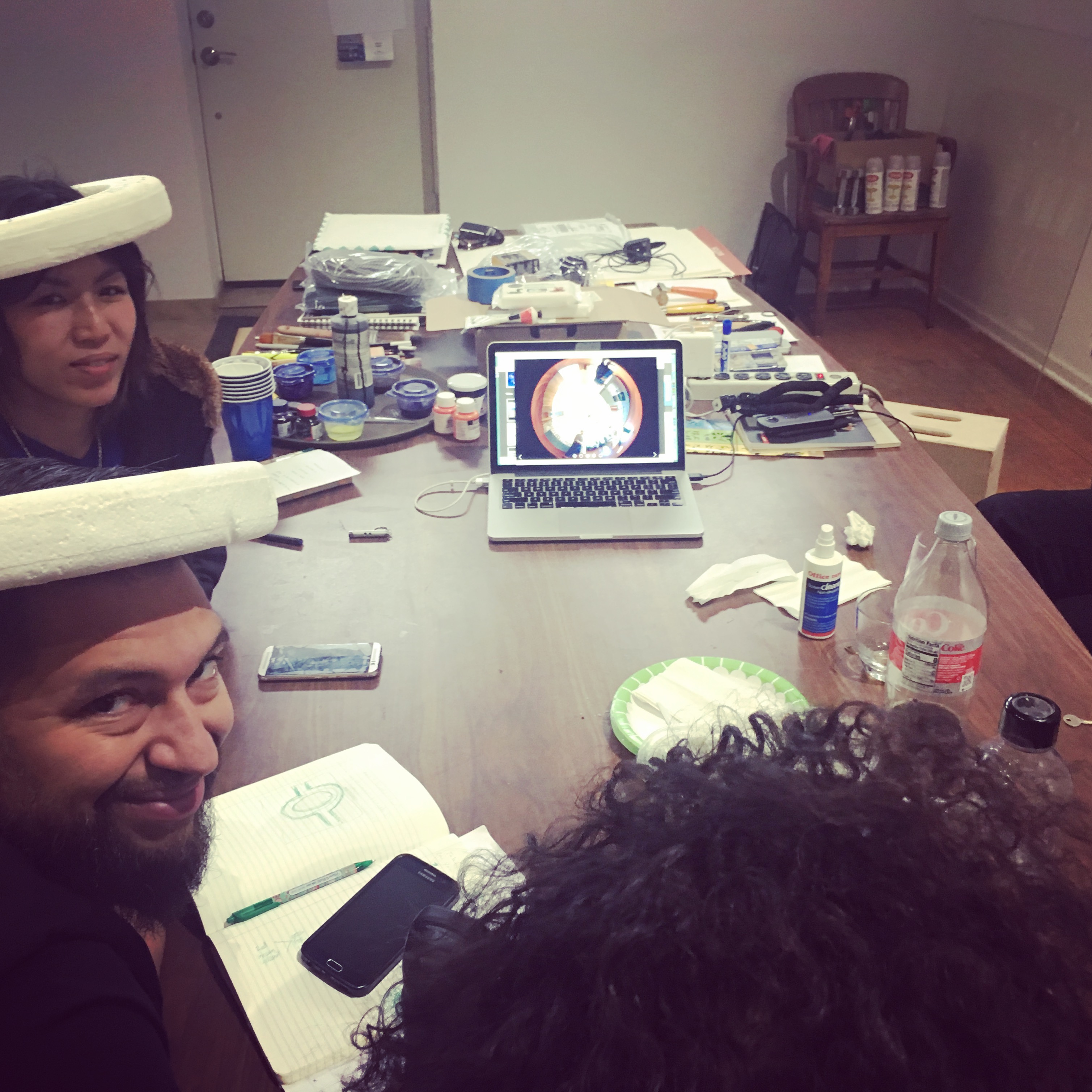
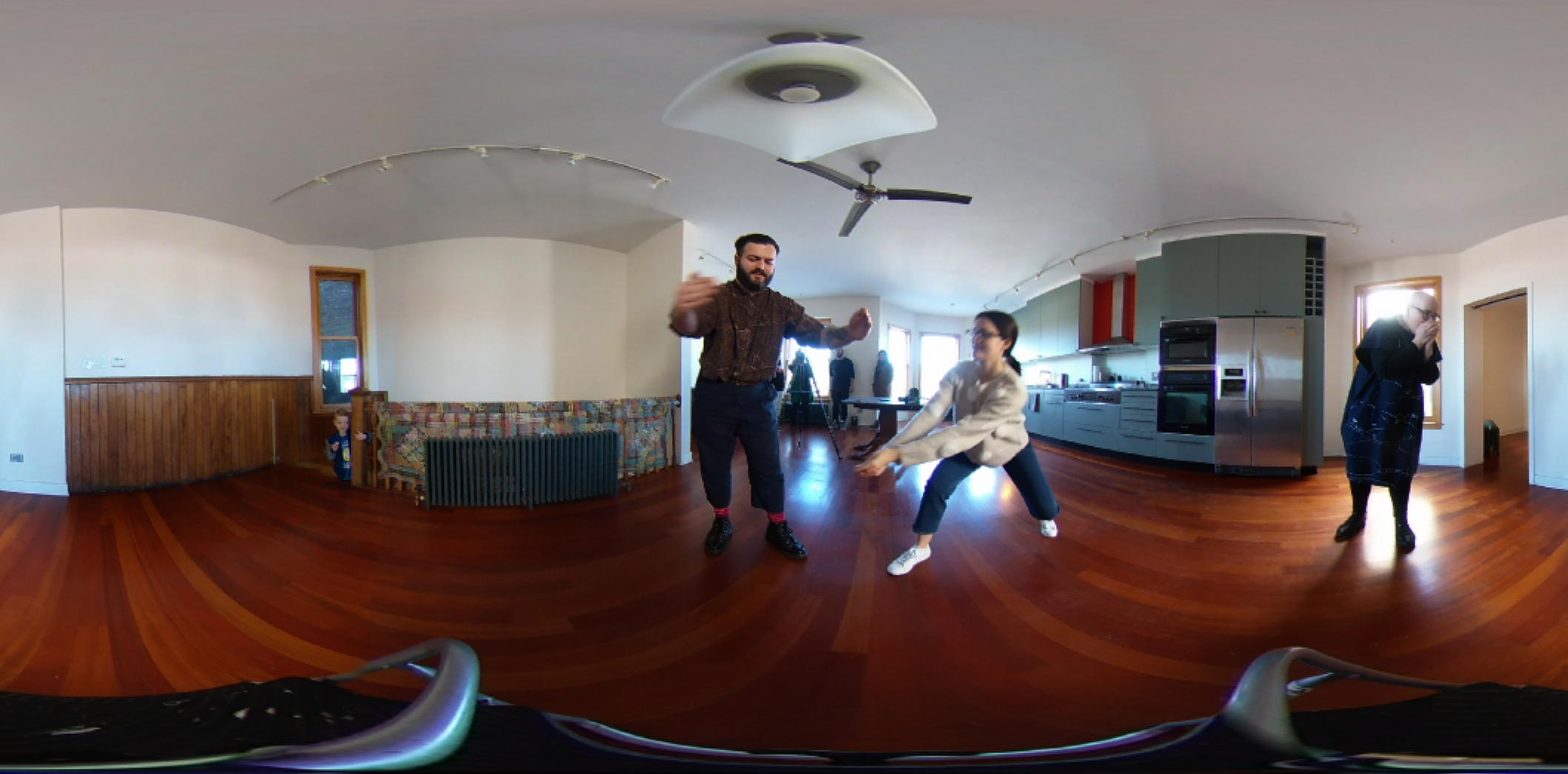
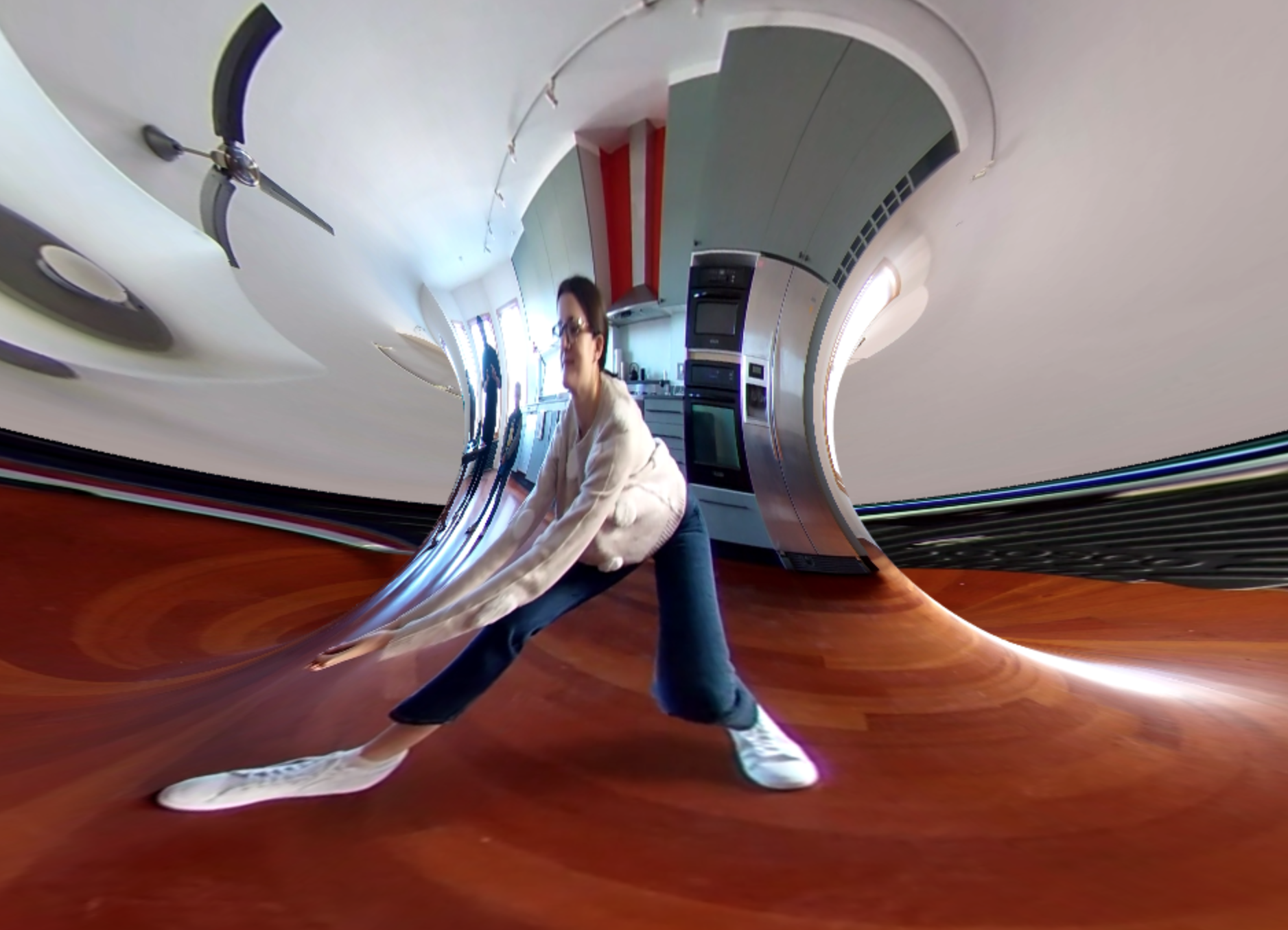
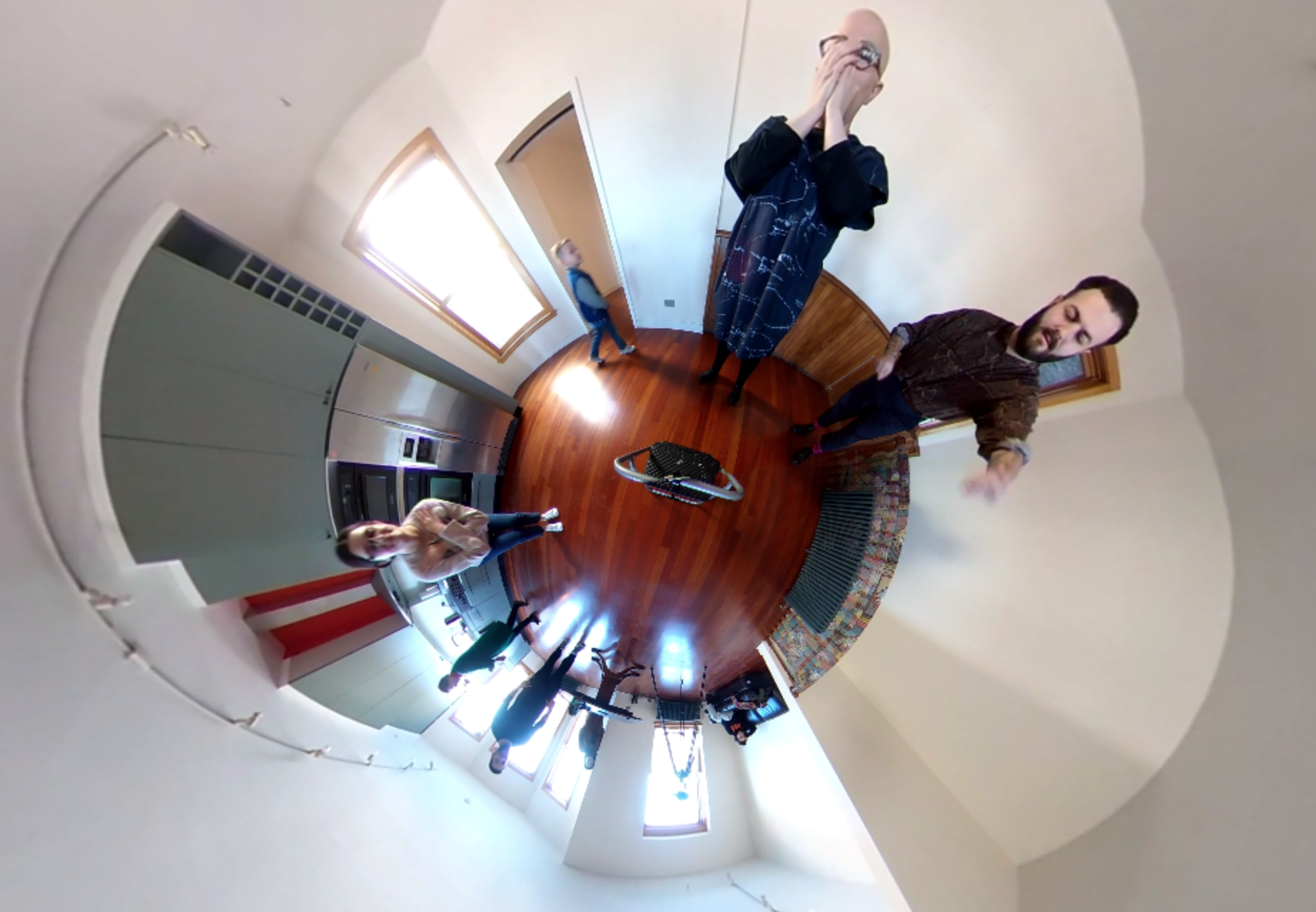
Research in Vienna: Interview Methods
October 2018
Research continued in Vienna with gender studies theorist Doris Ingrisch. As part of a project funded through a grant from the University of Music and Performing Arts through which we are learning more about artist conversations, we met with two performance artists, Doris Uhlich and Gabri Einsiedl, and with two composer/musicians, Maria Gstättner and Stefan Heckel. (Next steps in January.)
Block Seminar at the Bauhaus University Weimar
October 2018
For two weeks, also in October 2018, the studio moved to the Bauhaus University Weimar, on the invitation of Professor of Media Environments, Ursula Damm. Here, a seminar was the context for continued work on the game. While the game had emerged and developed intuitively in Chicago over the summer, in Weimar we used the block seminar structure with its daily meetings to formalize the sequence of game prompts, observe performance iterations and bring in readings. We experimented with drawing the game figures, and started to dig ‘in between’ the steps of the sequence. With Sandra Anhalt, Maud Canisius, Tamara Conde, Laura Giraldo Diaz, Vanessa Engelmann, Regine Elbers, Lara Hann, Sarah Hermanutz, Yen Ruo-Jin, Margarita Valdivieso.
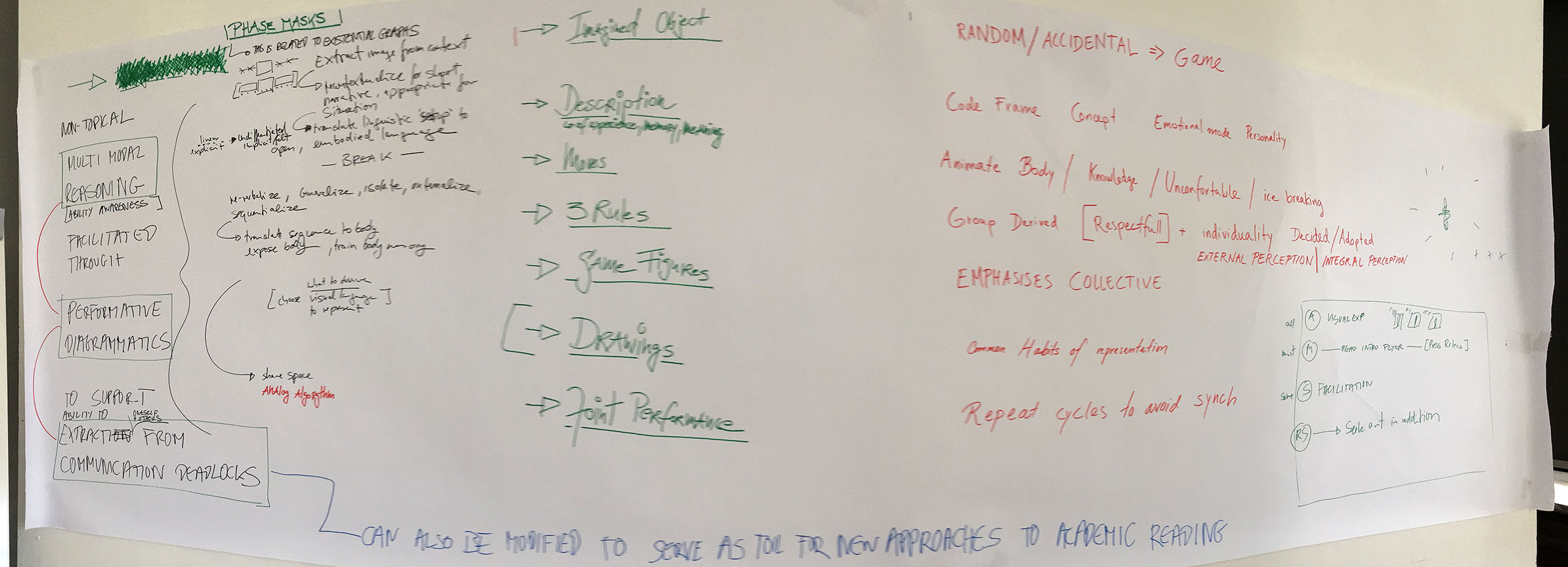
We are beginning to dig into the transpositions that appear to occur in the gaps between steps.
In the Studio
8/3/18
With Vero D Orozco, Joseph Losinski, Sergio Mantilla, Laura Cardozo, Ed Diaz Trujillo,
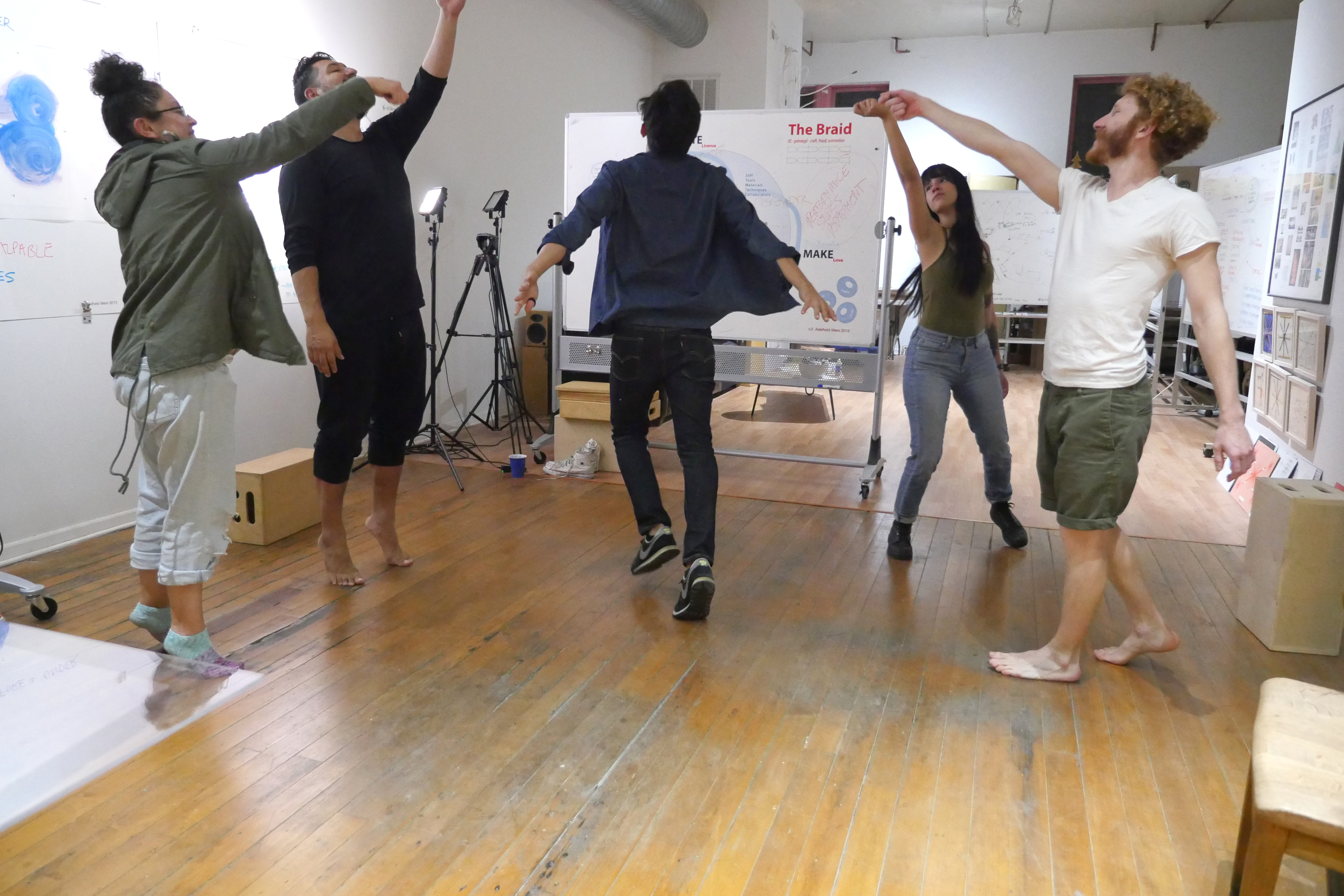
We’re working out language – playing a game, making a game, devising game figures
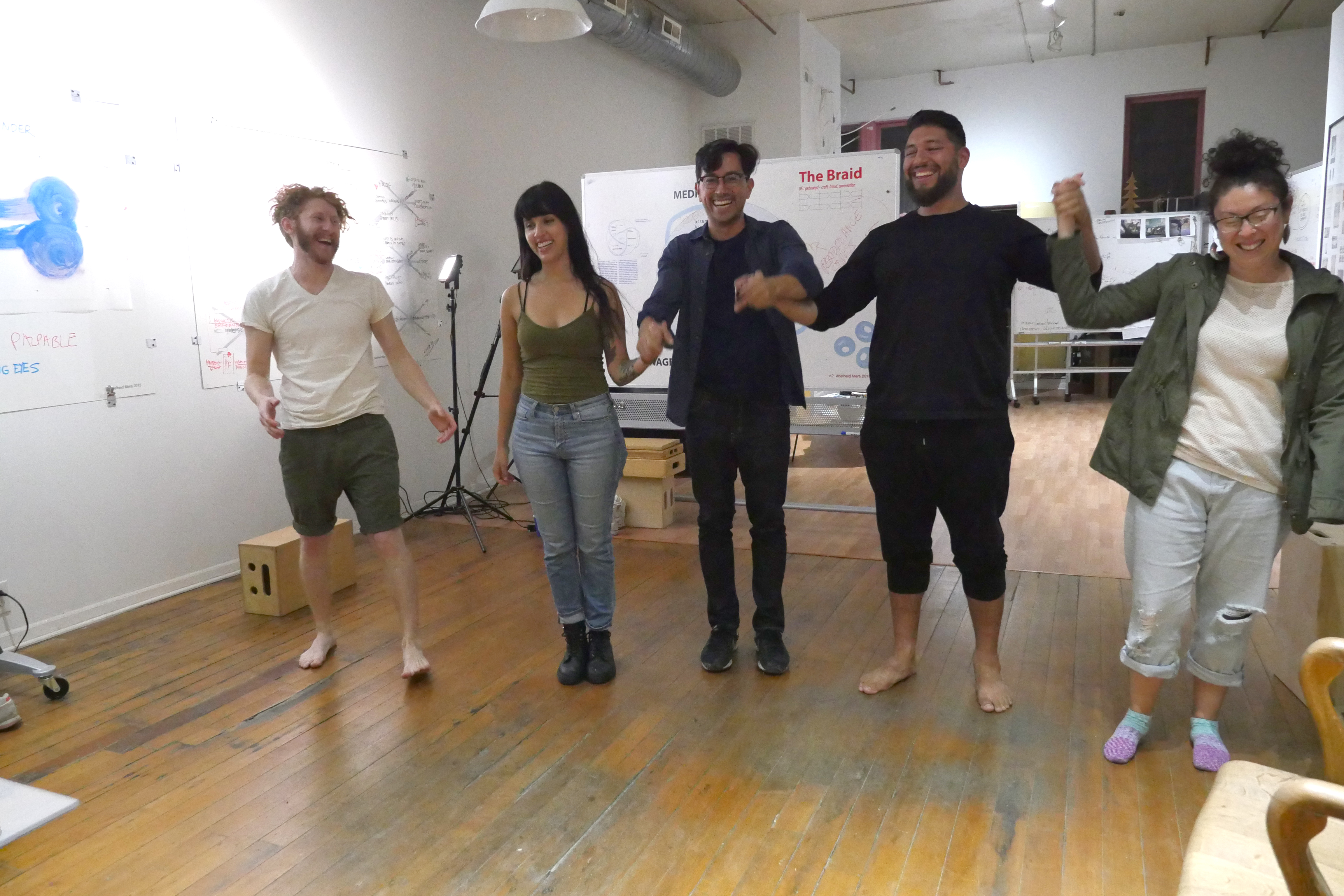
Taking a bow
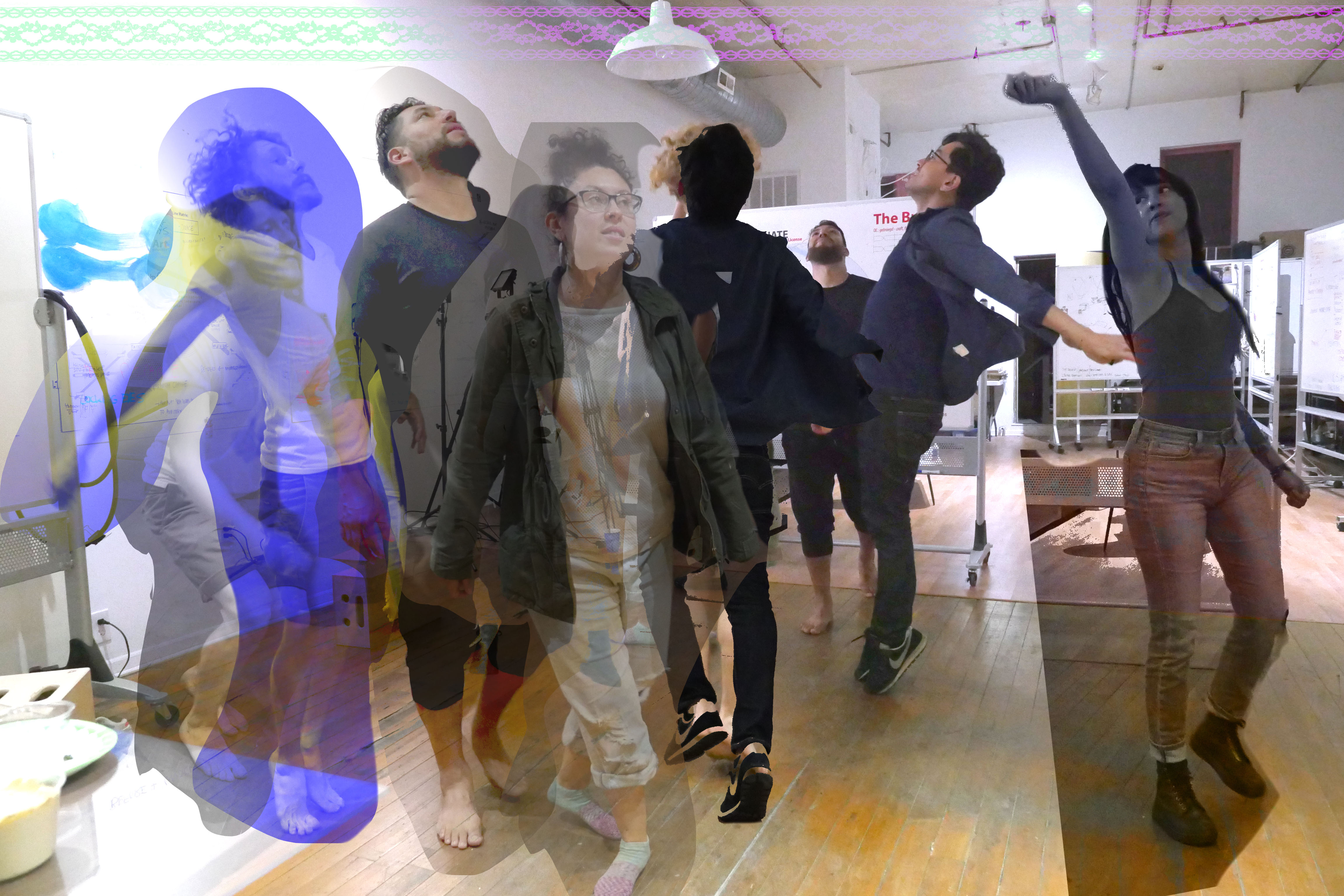
Later, playing with composites
In the Studio
7/16/18
With Vero D Orozco, Ed Diaz Trujillo, Giannella Ysasi
In the Studio
6/18/18
With Vero D Orozco, Joseph Losinski, Ed Diaz Trujillo, Caroline Ng
In the Studio
6/30/18
With Kenneth Bailey, Judith Leemann, Billie Lee, Poor Farm after party
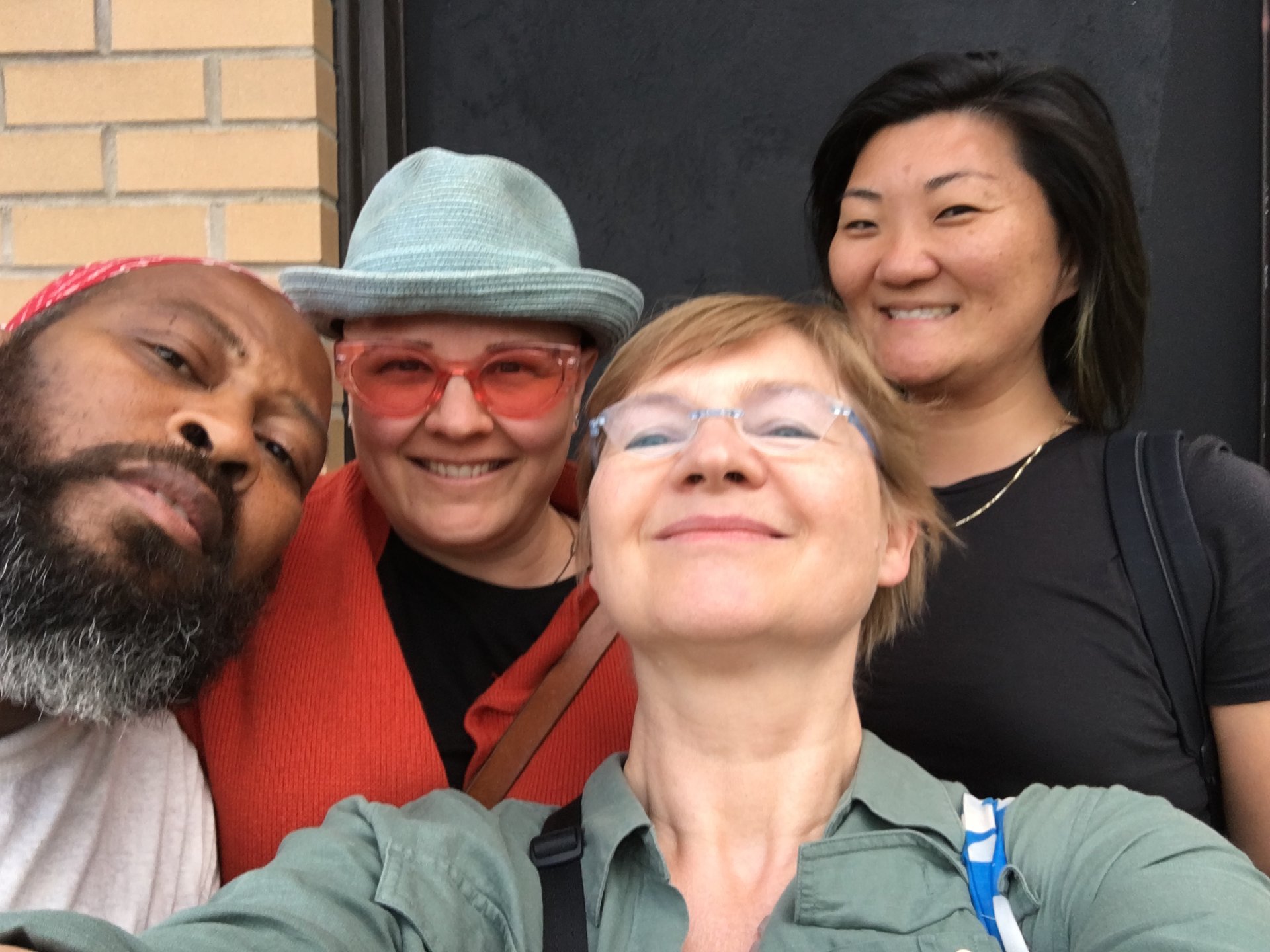
In the Studio
6/6/18
With Tracie Hall and DeAmon Harges, comparing notes from the Artist as Problem Solver Convening, a follow-up meeting.
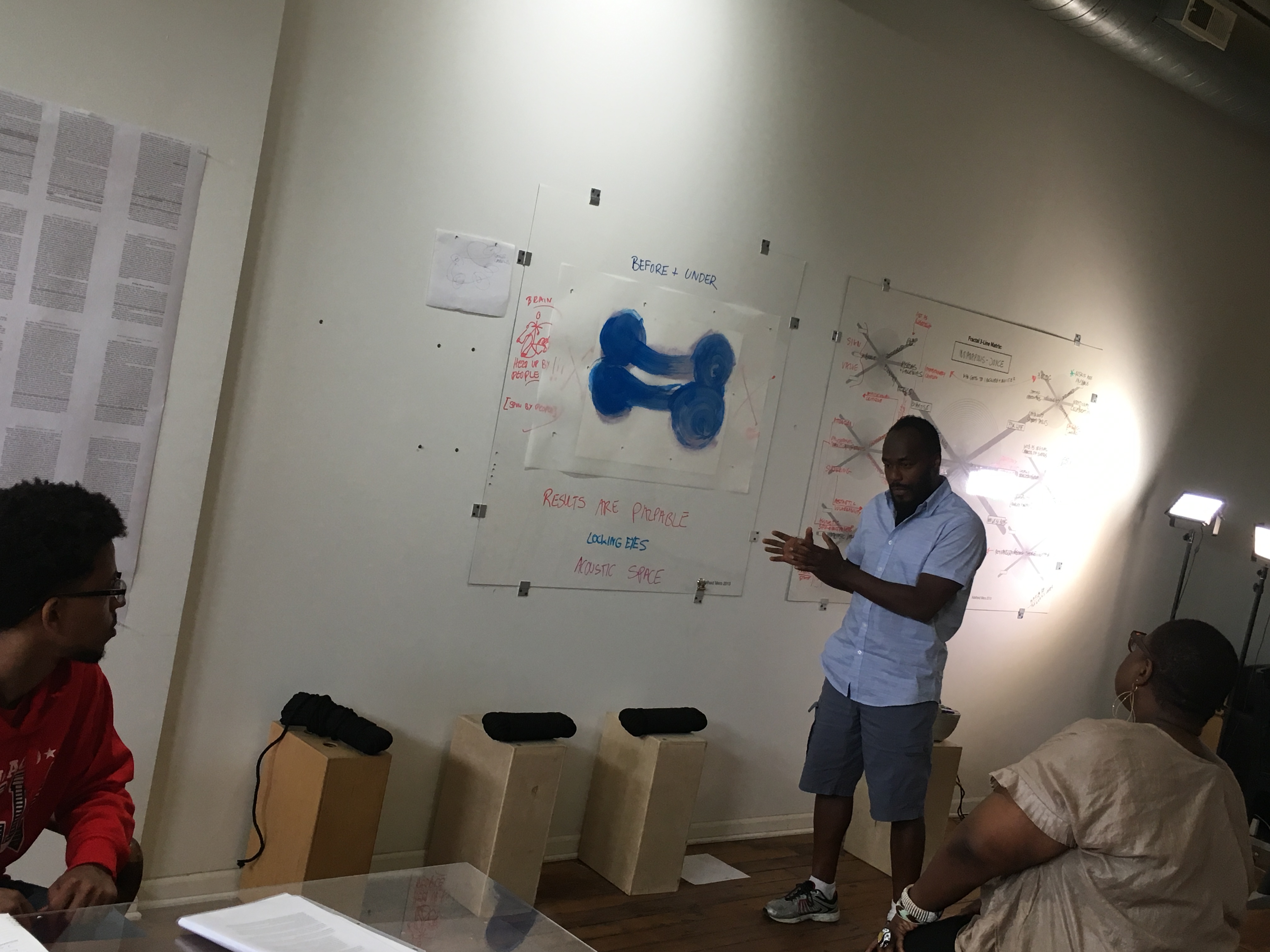
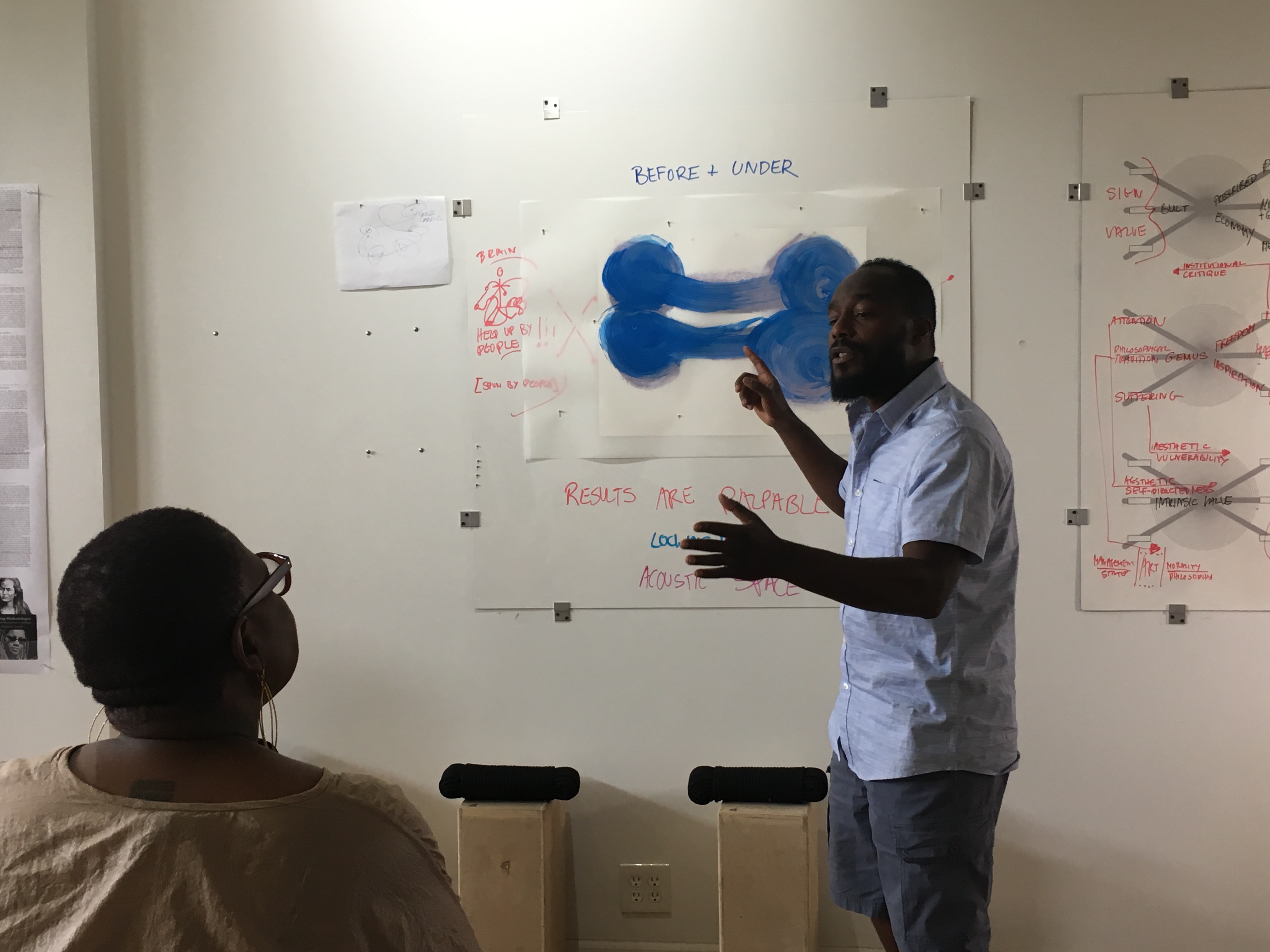 DeAmon was at the convening as “Roving Listener” and shared his observations and responses at the end. Here he reacts to a visual element of my response, one of a series of layered drawings. More about DeAmon’s work here.
DeAmon was at the convening as “Roving Listener” and shared his observations and responses at the end. Here he reacts to a visual element of my response, one of a series of layered drawings. More about DeAmon’s work here.
The Gaze – this set of 20 drawings on transparent backgrounds is part of the response to the Artist as Problem Solver Convening. Here, digitized versions are randomly superimposed in groups of four each time the site is refreshed. The number of possible combinations is 20!/16! = 20 x 19 x 18 x 17 = 116,280. (Tap/click/Command R to refresh after clicking through to site)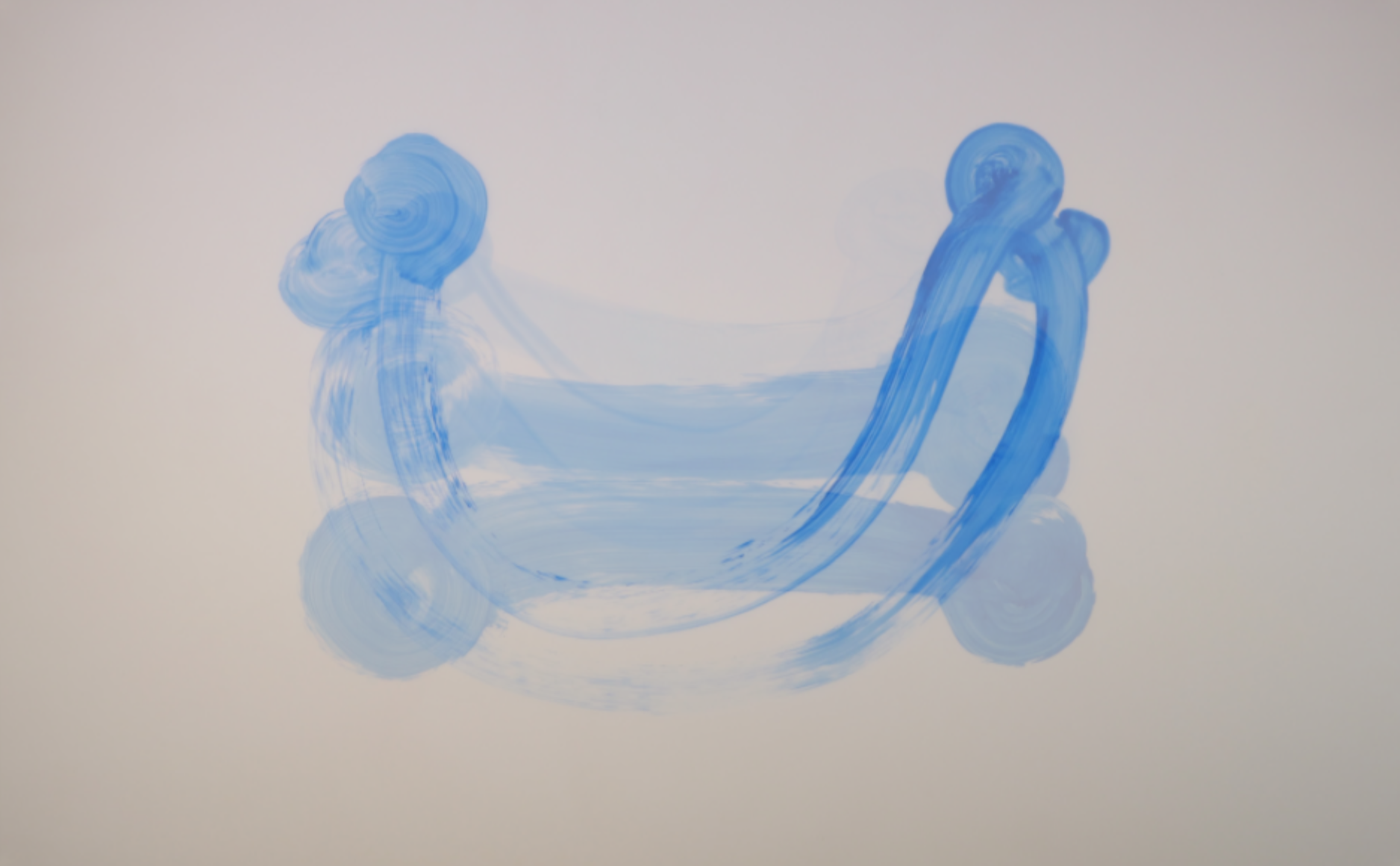
Artist as Problem Solver Convening, Joyce Foundation, Indianapolis, March 2018
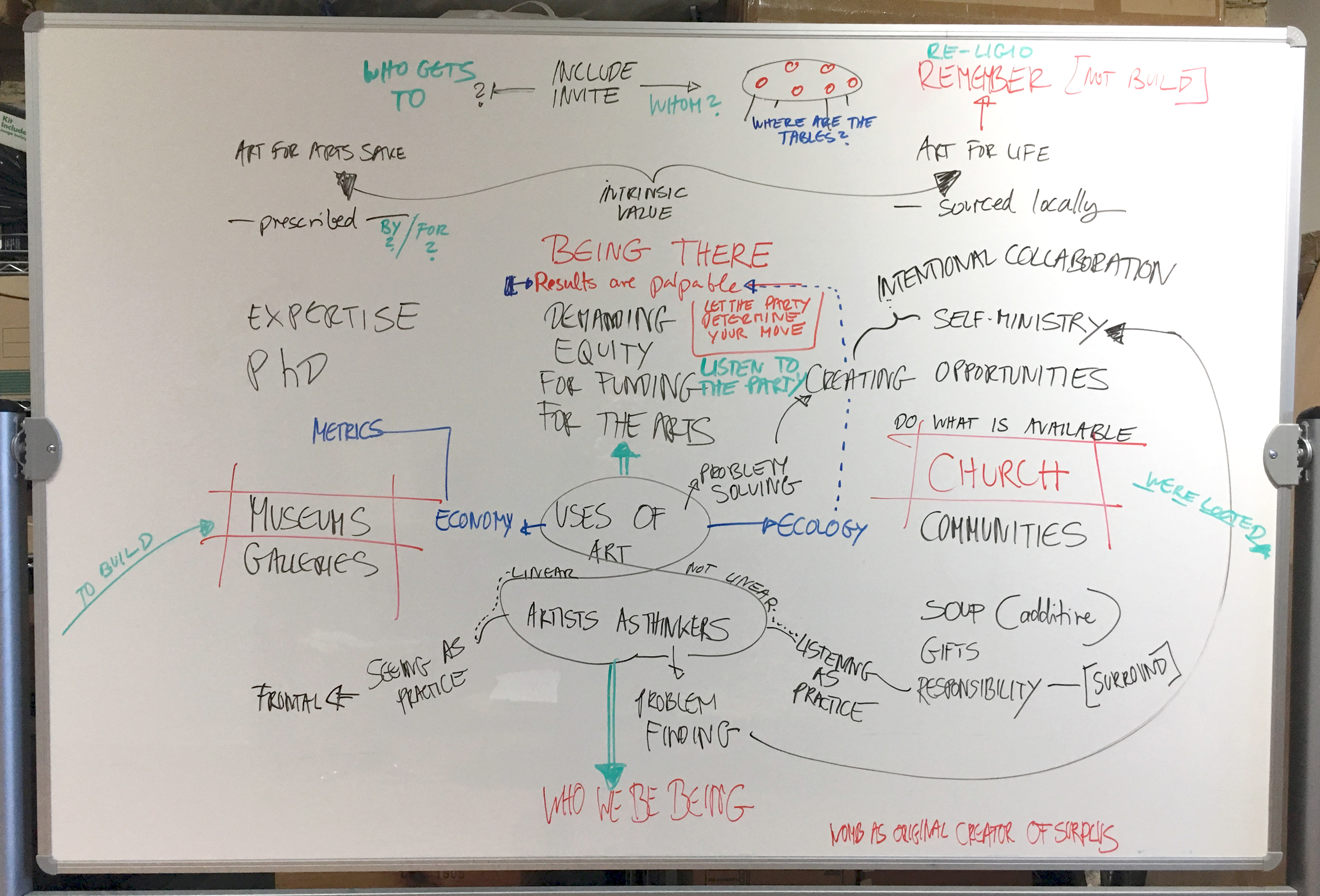
summary of convening notes
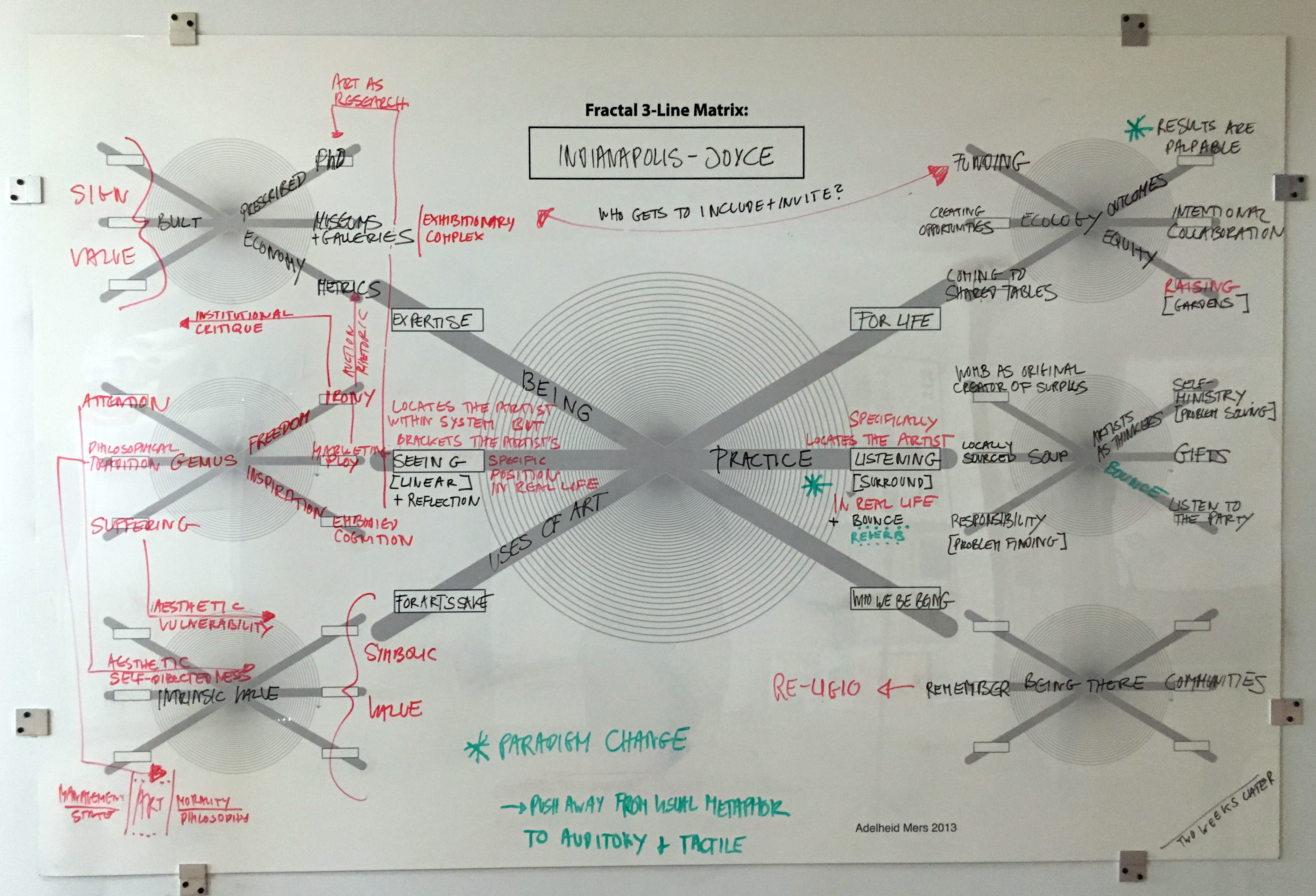
Convening notes as Fractal 3-Line Matrix
Read linear notes here
Convening participants and topics
In the Studio
Wearing the Braid
In the Studio
12/9/17
With Asha Veal, Nicolas Melo, Dio Aldridge, Walking the Braid.
In the Studio
11/11/17
With Asha Veal, Greg Ruffing, Walking the Braid. Prototyping a different activation of the Braid, a shift in perception occurred. From here on, performative aspects of the work, always already present in diagram uses, now took center stage.
The Talking Whiteboards Studio Project
Summer 2016
Most participants in this project engaged The Braid whiteboard, exploring their own modes of working while taking cues from the categories it displays. The Braid diagram emerged earlier this year from my ongoing conversations with artists about their practices.
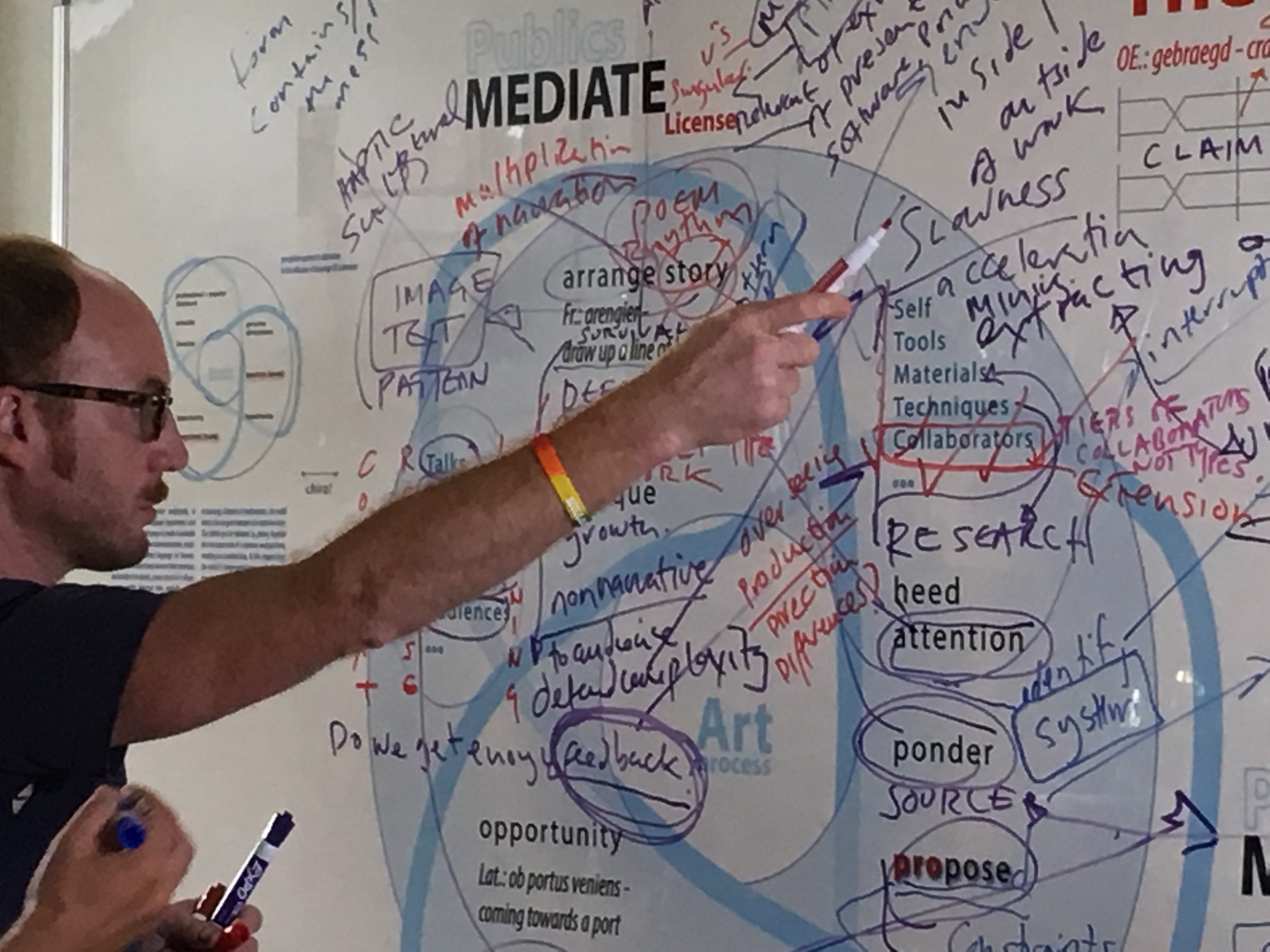
Final Talking Whiteboards edits on vimeo channel
How do you work?
ongoing
Conversations with experimental musicians, composers, and visual artists about their practices, followed by my visualizations of the conversations. In turn, artist’s respond to the visualizations. Since conversations happen in many different places, some of the responses later take place long-distance. Included here are responses that took place in my studio, and in one case, at a studio I had use of during a residency.
Visualizations, seen on the wall behind the artists or musicians, come in two versions – a freely composed scenario (left), and text entered into a Fractal 3-Line Matrix (right). Responses tend to be offered in the artist’s own medium.
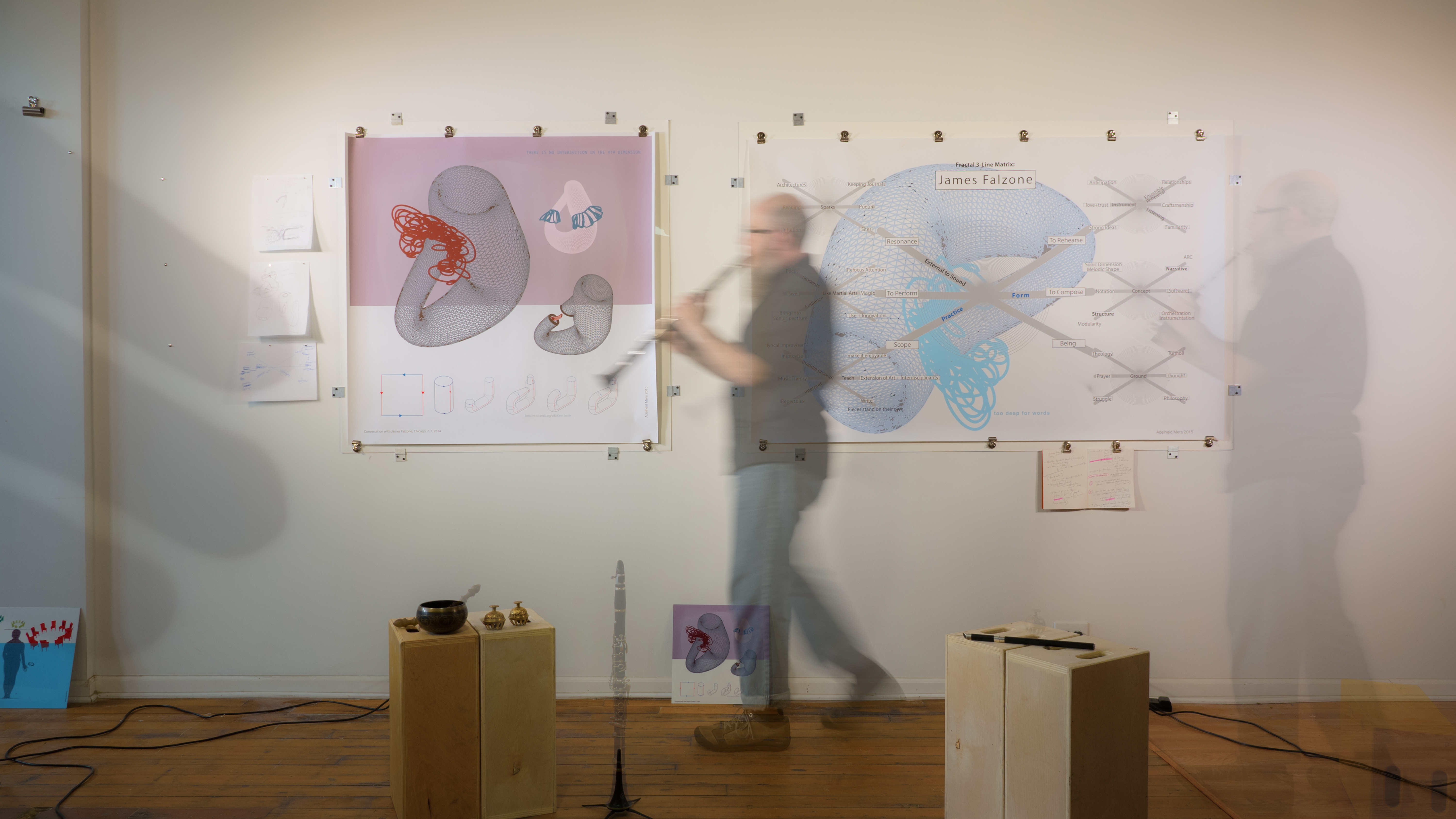
With James Falzone, who responded to visualizations of our How do you work? conversation. Shown is a composite image of documentation.
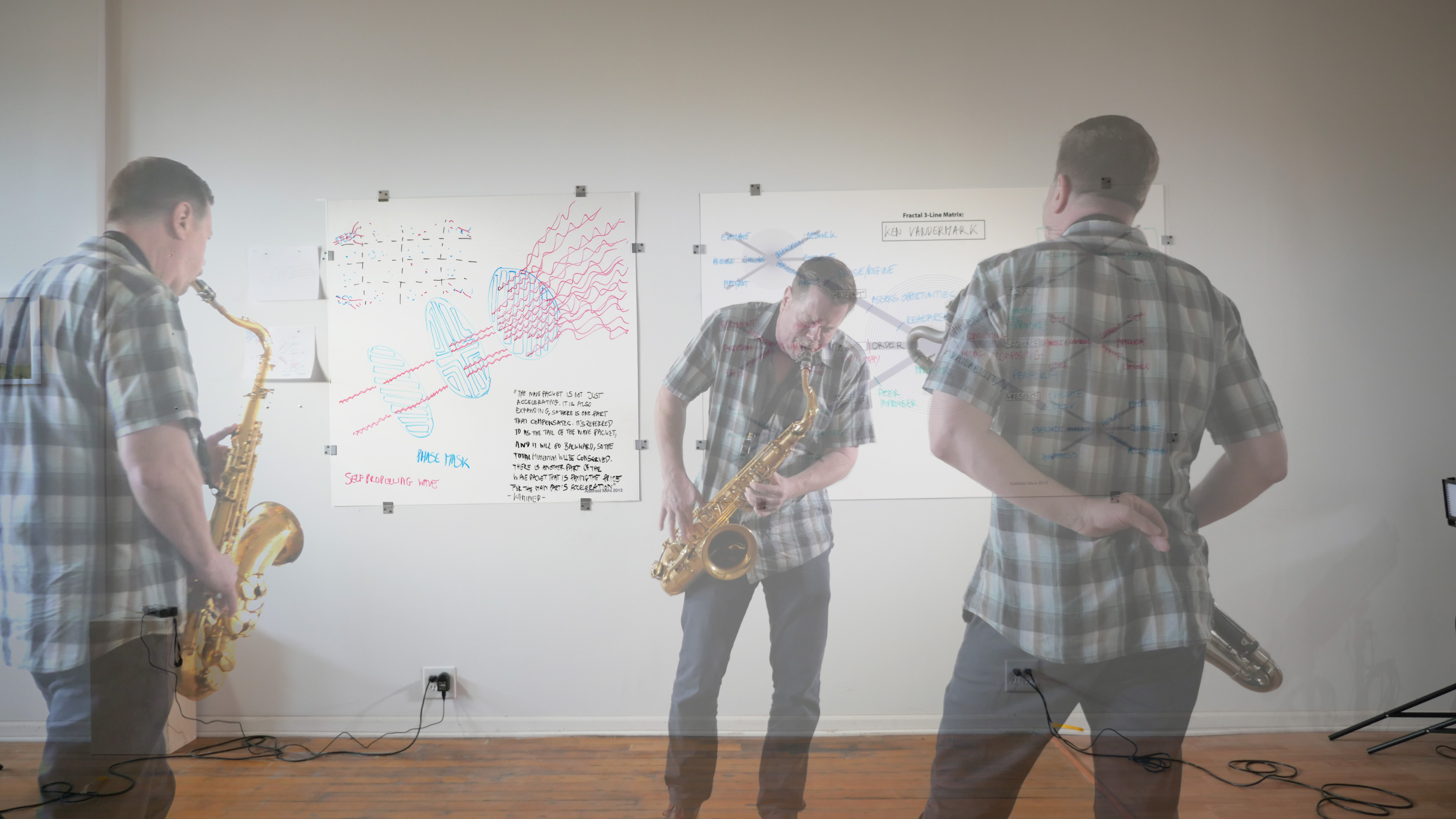
With Ken Vandermark, who responded to visualizations of our How do you work? conversation. Shown is a composite image of documentation.

With Tomeka Reid, who responded to visualizations of ourHow do you work? conversation, at the Roger Brown Studio in New Buffalo, Michigan. Shown is a composite image of documentation.
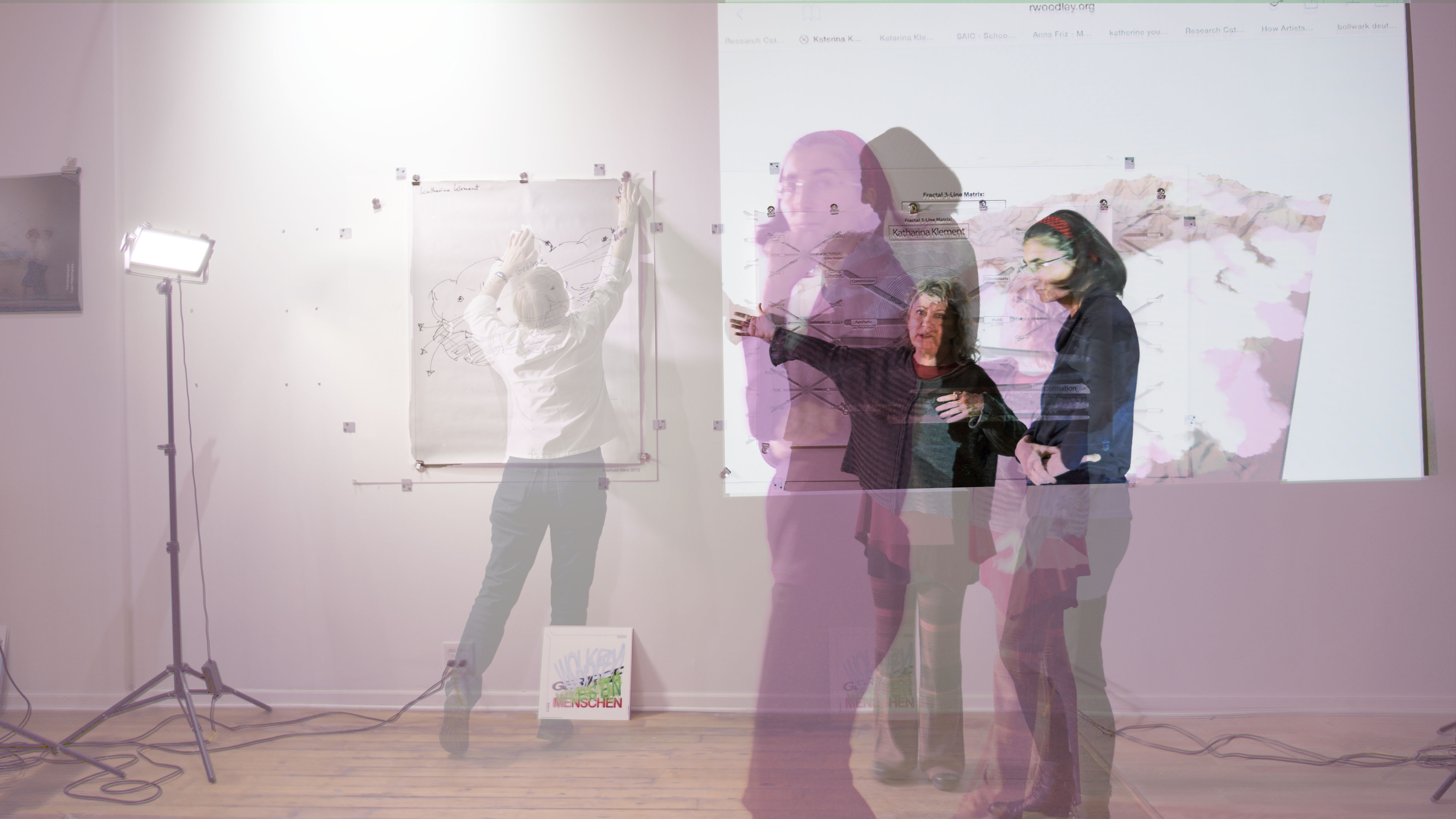
With Katharina Klement, who responded to visualizations of our How do you work? conversation. Also participating, Lynn Book. Shown is a composite image of documentation.
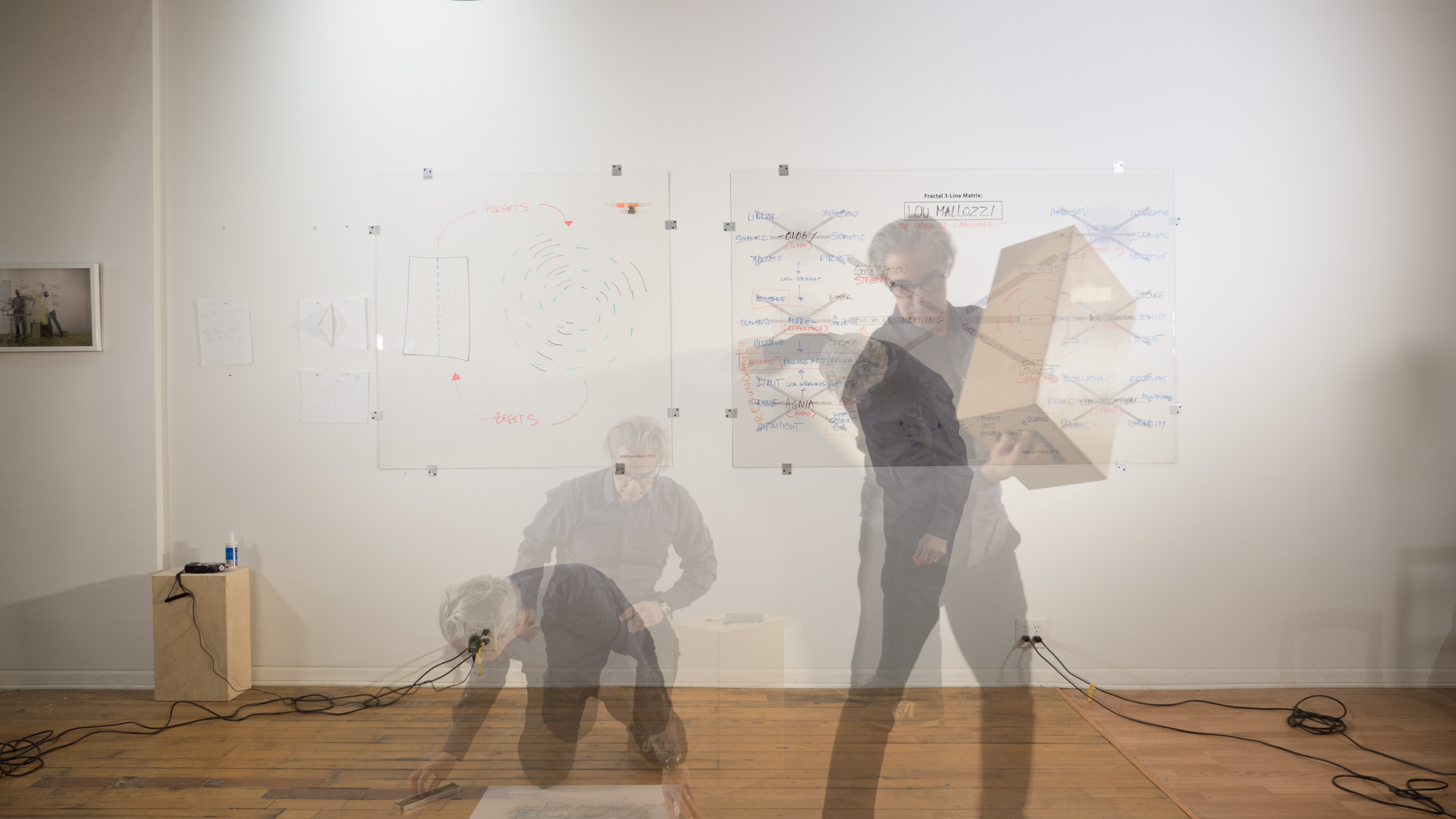
With Lou Mallozzi, who responded to visualizations of our How do you work? conversation. Shown is a composite image of documentation. More about this conversation is published with Chicago Artist Writers, here.
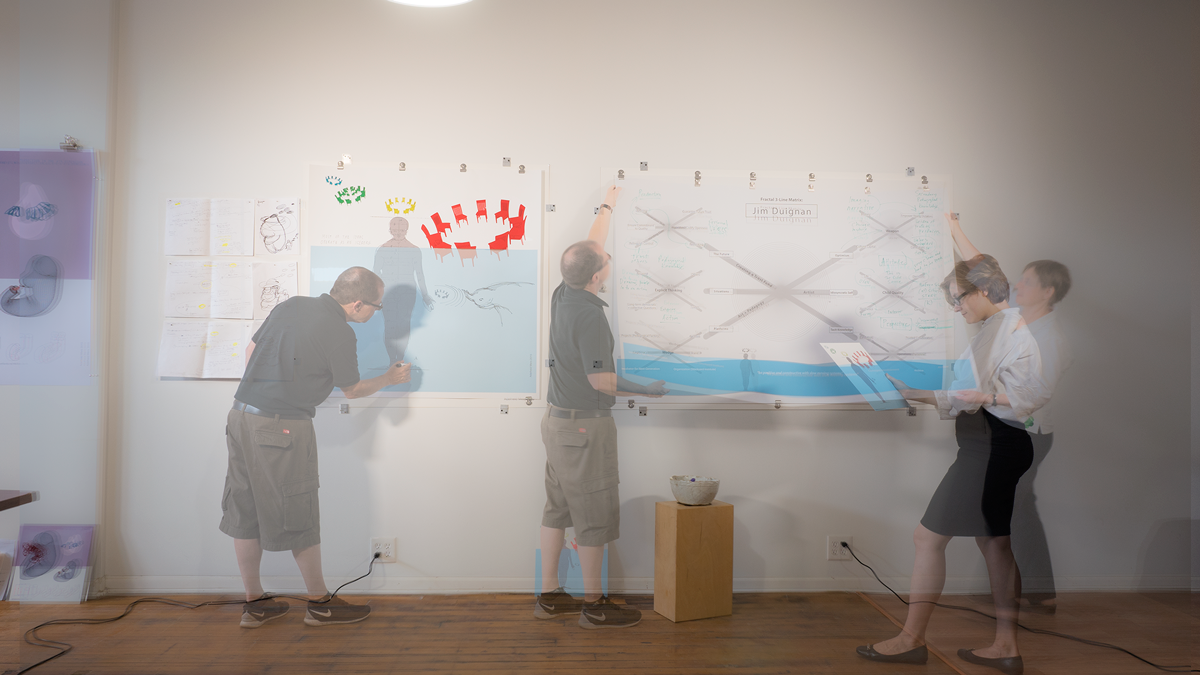
With Jim Duignan, who responded to visualizations of our How do you work? conversation. Also participating, Katya Balueva. Composite image of documentation. Shown is a composite image of documentation.
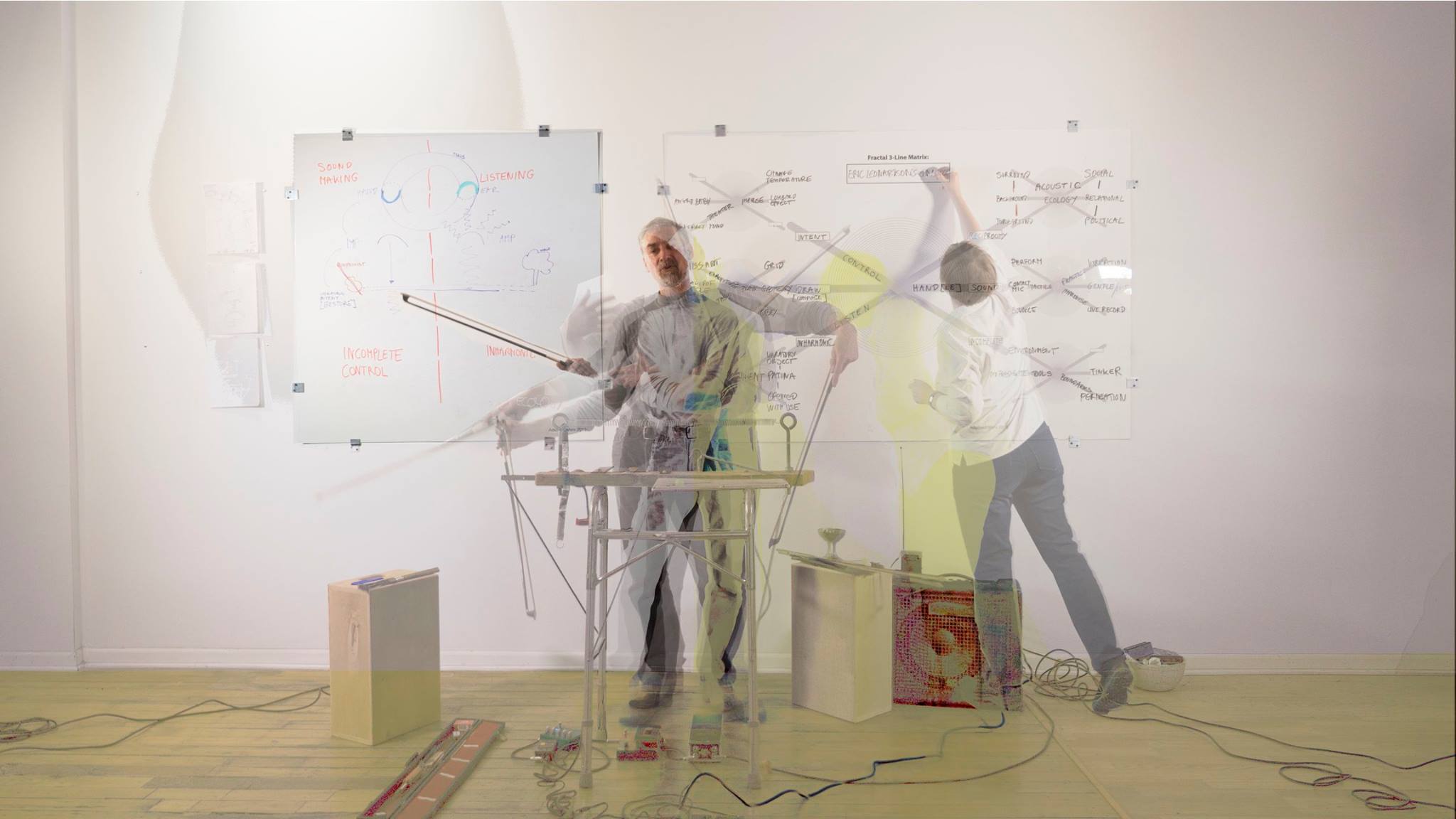
With Eric Leonardson, who responded to visualizations of our How do you work? conversation. Shown is a composite image of documentation.
More about the ongoing series of conversations, visualizations and responses.
In the Studio
1/27/2016
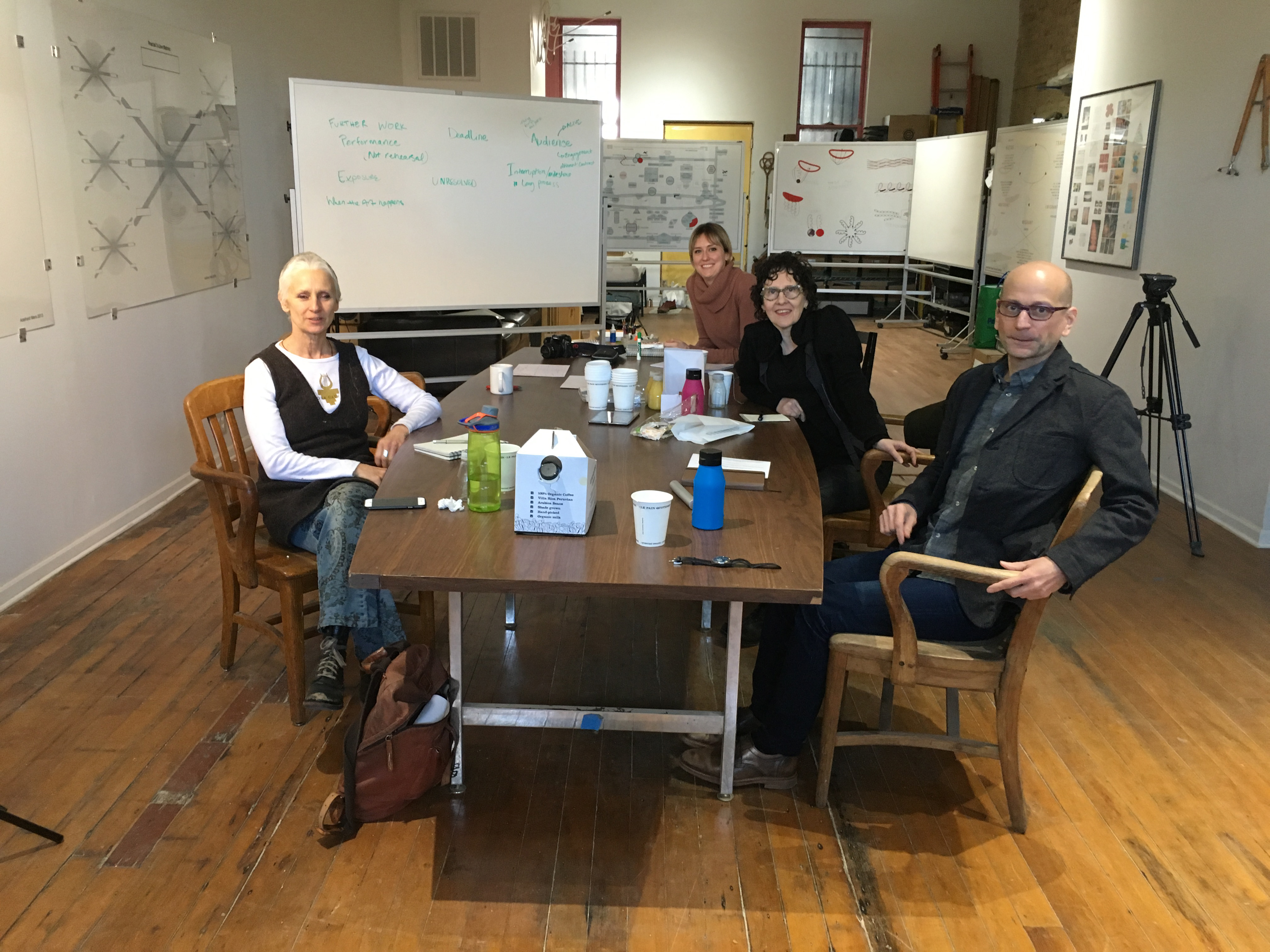
Inaugurating the newly renovated studio space with a conversation about attending and engagement, with Lin Hixson, Matthew Goulish, K.J. Holmes and Sarah Skaggs, 1/27/2016





























